Inside Unit 731, Japan’s Disturbing Human Experiments Program During World War II
These six "experiments" by unit 731 rank among some of the most horrifying war crimes ever committed — and they went virtually unpunished..
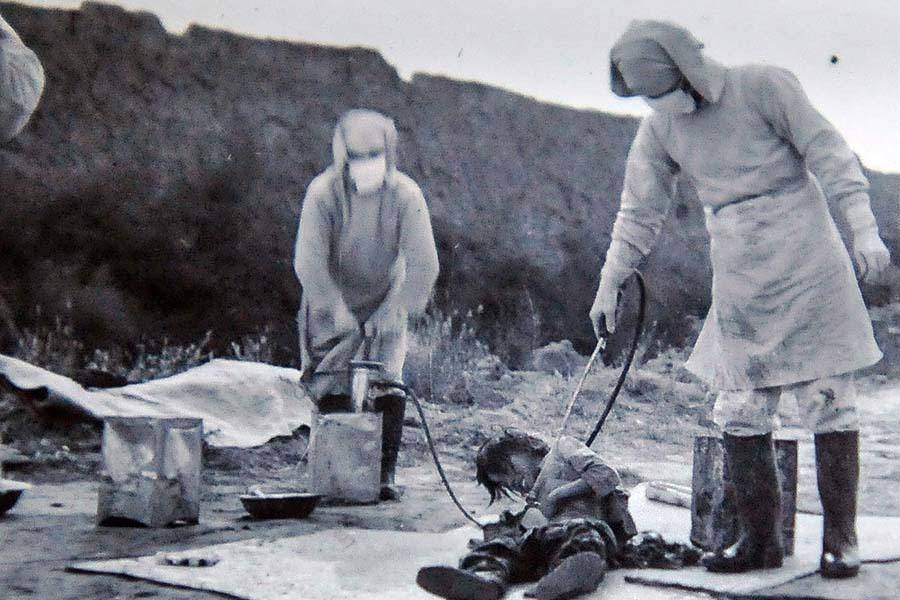
Xinhua via Getty Images Unit 731 personnel conduct a bacteriological trial upon a test subject in Nong’an County of northeast China’s Jilin Province. November 1940.
World War II devastated the lives of more than 100 million people around the world. And out of all the areas in which World War II was fought, none were active as long as what would come to be known as the Pacific Theater. In fact, Japan arguably started the war by attacking Manchuria in 1931, and it inarguably waged war with China by invading in 1937.
The disturbances and upheavals that these invasions caused shook China to its very foundations, triggered a civil war and a famine that probably killed more people than currently live in Canada and Australia combined, and lasted until the country’s Soviet “liberation” in 1945.
And out of all the atrocities that Imperial Japan unleashed upon the Chinese people during this brutal occupation, probably none were as gratuitously hateful as the operations of Unit 731, the Japanese Empire ‘s biological warfare unit that somehow plumbed new depths in what was already a genocidal war.
Despite innocent beginnings as a research and public health agency, Unit 731 eventually grew into an assembly line for weaponized diseases that, if fully deployed, could have killed everyone on Earth several times over. All this “progress” was, of course, built on the limitless suffering of human captives, who were held as test subjects and walking disease incubators until Unit 731 was shut down at the end of the war.
But before Unit 731 was broken up in 1945, it committed some of the most torturous human experiments in recorded history.
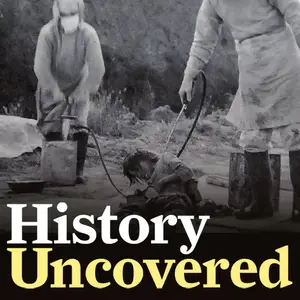

Unit 731 Experiments: Frostbite Testing

Xinhua via Getty Images The frostbitten hands of a Chinese person who was taken outside in winter by Unit 731 personnel for an experiment on how best to treat frostbite. Date unspecified.
Yoshimura Hisato, a physiologist assigned to Unit 731, took a special interest in hypothermia. As part of Maruta’s study in limb injuries, Hisato routinely submerged captives’ limbs in a tub of water filled with ice and had them held until the arm or leg had frozen solid and a coat of ice had formed over the skin. According to one eyewitness account , the limbs made a sound like a plank of wood when struck with a cane.
Hisato then tried different methods for rapid rewarming of the frozen appendage. Sometimes he did this by dousing the limb with hot water, sometimes by holding it close to an open fire, and other times by leaving the subject untreated overnight to see how long it took for the person’s own blood to thaw it out.
Recent Posts
archaeology
10-Year-Old Boy Discovers An 18th-Century Sword With A Metal Detector He Just Got For His Birthday
By All That's Interesting
ancient history
Early Humans Used 2-Million-Year-Old Stone Balls To Get To Bone Marrow, New Study Finds
sentiment captivating
7 Of The Most Terrifying Creatures From Native American Mythology
Vivisection Of Conscious Captives
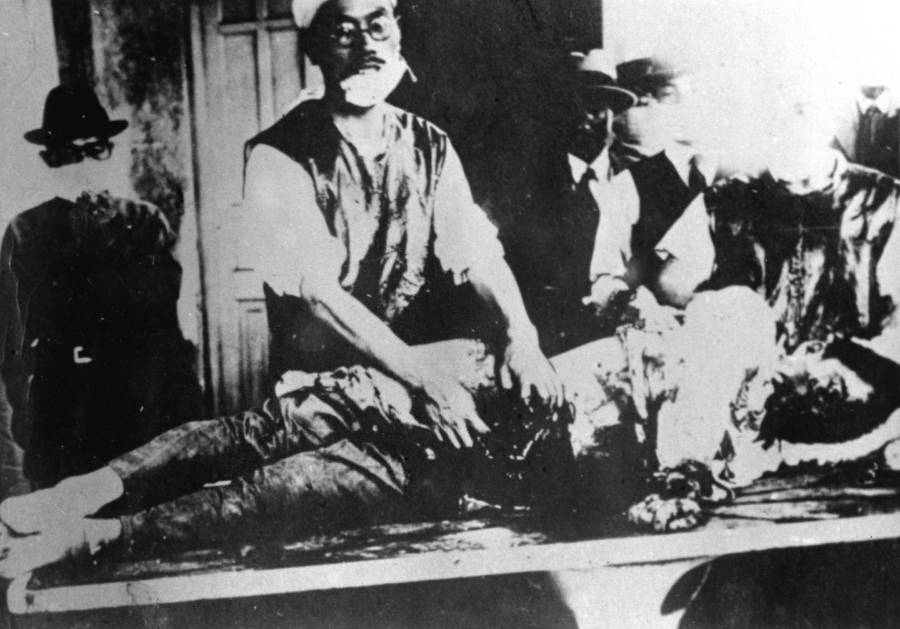
Xinhua via Getty Images A Unit 731 doctor operates on a patient that is part of a bacteriological experiment. Date unspecified.
Unit 731 started out as a research unit, investigating the effects of disease and injury on the fighting ability of an armed force. One element of the unit, called “Maruta,” took this research a little further than the usual bounds of medical ethics by observing injuries and the course of disease on living patients.
At first, these patients were volunteers from the ranks of the army, but as the experiments reached the limits of what could be non-invasively observed, and as the supply of volunteers dried up, the unit turned to the study of Chinese POWs and civilian captives.
And as the concept of consent went out the window, so did the restraint of the researchers. It was around this time that Unit 731 began referring to confined research subjects as “logs,” or “Maruta” in Japanese.
Study methods in these experiments were barbaric.
Vivisection, for example, is the practice of mutilating human bodies, without anesthesia, to study the operations of living systems. Thousands of men and women, mostly Chinese communist captives as well as children and elderly farmers, were infected with diseases such as cholera and the plague, then had their organs removed for examination before they died in order to study the effects of the disease without the decomposition that occurs after death.
Subjects had limbs amputated and reattached to the other side of the body, while others had their limbs crushed or frozen, or had the circulation cut off to observe the progress of gangrene.
Finally, when a prisoner’s body was all used up, they would typically be shot or killed by lethal injection, though some may have been buried alive. None of the Chinese, Mongolian, Korean, or Russian captives assigned to Unit 731 survived their confinement.
Unit 731’s Horrifying Weapons Tests
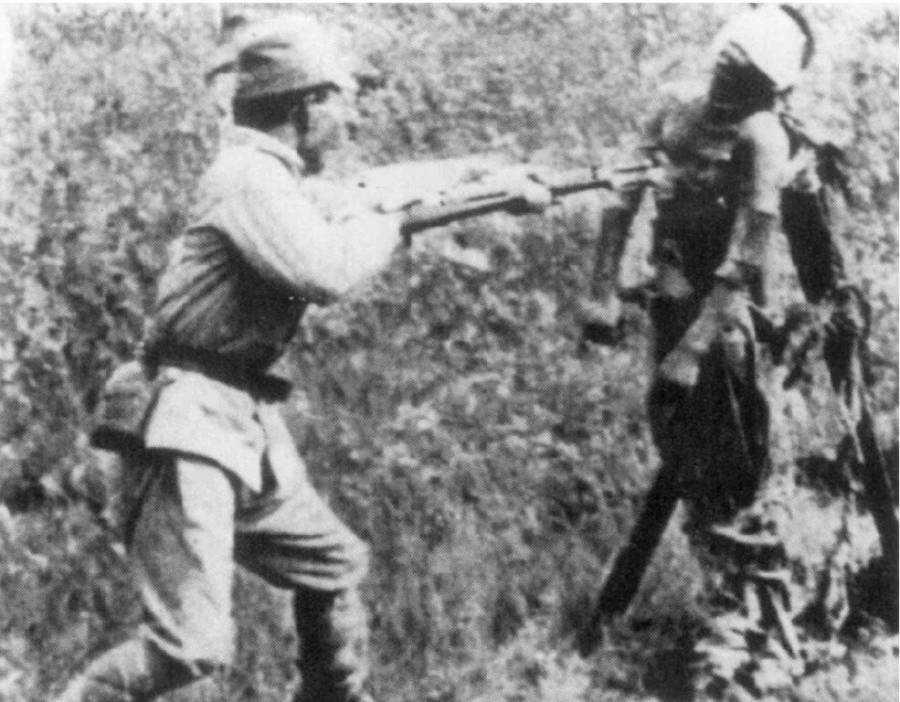
Associated Press/ LIFE via Wikimedia Commons A Japanese soldier uses a Chinese man’s body for bayonet practice near Tianjin, China. September 1937.
The effectiveness of various weapons was of obvious interest to the Japanese Army. To determine effectiveness, Unit 731 herded captives together on a firing range and blasted them from varying ranges by multiple Japanese weapons, such as the Nambu 8mm pistol, bolt-action rifles, machine guns, and grenades. Wound patterns and penetration depths were then compared on the bodies of the dead and dying inmates.
Bayonets , swords, and knives were also studied in this way, though the victims were usually bound for these tests. Flamethrowers were also tested, on both covered and exposed skin. In addition, gas chambers were set up at unit facilities and test subjects exposed to nerve gas and blister agents.
Heavy objects were dropped onto bound victims to study crush injuries, subjects were locked up and deprived of food and water to learn how long humans could survive without them, and victims were allowed to drink only sea water, or were given injections of mismatched human or animal blood to study transfusions and the clotting process.
Meanwhile, prolonged X-ray exposure sterilized and killed thousands of research participants, as well as inflicting horrible burns when the emitting plates were miscalibrated or held too close to the subjects’ nipples, genitals, or faces.
And to study the effects of high G-forces on pilots and falling paratroopers, Unit 731 personnel loaded human beings into large centrifuges and spun them at higher and higher speeds until they lost consciousness and/or died, which usually happened around 10 to 15 G’s, though young children showed a lower tolerance for acceleration forces.
Syphilis Experiments On Unit 731 Captives
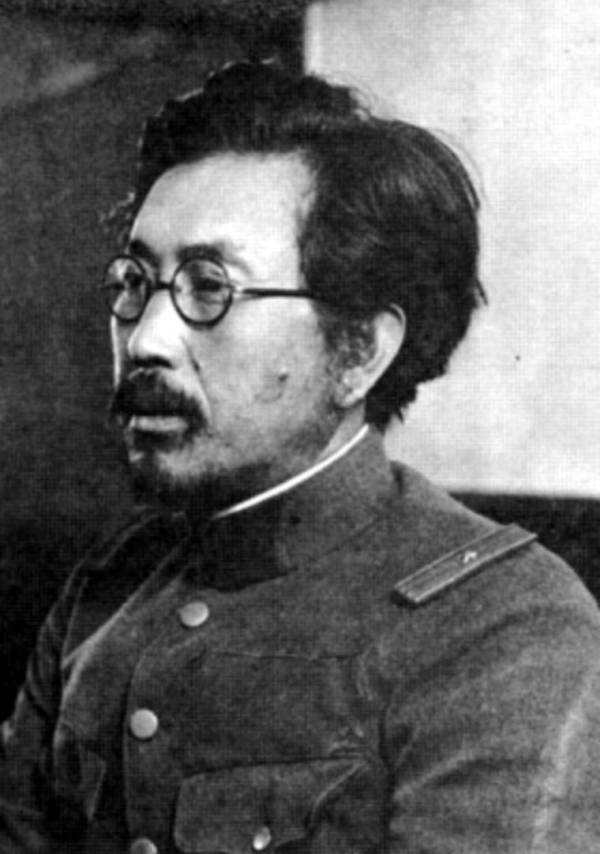
Wikimedia Commons General Shiro Ishii , the commander of Unit 731.
Venereal disease has been the bane of organized militaries since ancient Egypt, and so it stands to reason that the Japanese military would take an interest in the symptoms and treatment of syphilis .
To learn what they needed to know, doctors assigned to Unit 731 infected victims with the disease and withheld treatment to observe the uninterrupted course of the illness. A contemporary treatment, a primitive chemotherapy agent called Salvarsan, was sometimes administered over a period of months to observe the side effects, however.
To ensure effective transmission of the disease, syphilitic male victims were ordered to rape both female and male fellow captives, who would then be monitored to observe the onset of the disease. If the first exposure failed to establish infection, more rapes would be arranged until it did.
Rape And Forced Pregnancy

Wikimedia Commons Unit 731’s Harbin facility.
Beyond just the syphilis experiments, rape became a common feature of Unit 731’s experiments .
For example, female captives of childbearing age were sometimes forcibly impregnated so that weapon and trauma experiments could be done on them.
After being infected with various diseases, exposed to chemical weapons, or suffering crush injuries, bullet wounds, and shrapnel injuries, the pregnant subjects were opened up and the effects on the fetuses studied.
The idea seems to have been to translate the teams’ findings into civilian medicine, but if Unit 731’s researchers ever published these results, the papers seem not to have survived the war years.
Germ Warfare On Chinese Civilians

Xinhua via Getty Images Unit 731 researchers conduct bacteriological experiments with captive child subjects in Nongan County of northeast China’s Jilin Province. November 1940.
The totality of Unit 731’s research was in support of their larger mission, which by 1939 was to develop horrific weapons of mass destruction for use against the Chinese population, and presumably American and Soviet forces, if the time ever came.
To this end, Unit 731 cycled through tens of thousands of captives at several facilities across Manchuria, which had been occupied by imperial forces for years. Inmates of these facilities were infected with several of the most lethal pathogens known to science, such as Yersinia pestis , which causes bubonic and pneumonic plague, and typhus, which the Japanese hoped would spread from person to person after being deployed and depopulate disputed areas.
To breed the most lethal strains possible, doctors monitored patients for rapid onset of symptoms and quick progression. Victims who pulled through were shot, but those who got sickest fastest were bled to death on a mortuary table, and their blood was used to transfect other captives, the sickest of whom would themselves be bled to transfer the most virulent strain to yet another generation.
One member of Unit 731 later recalled that very sick and unresisting captives would be laid out on the slab so a line could be inserted into their carotid artery. When most of the blood had been siphoned off and the heart was too weak to pump anymore, an officer in leather boots climbed onto the table and jumped on the victim’s chest with enough force to crush the ribcage, whereupon another dollop of blood would spurt into the container.
When the plague bacillus had been bred to what was felt to be a sufficiently lethal caliber, the last generation of victims to be infected were exposed to huge numbers of fleas, Y. pestis’ preferred vector of contagion. The fleas were then packed in dust and sealed inside clay bomb casings.
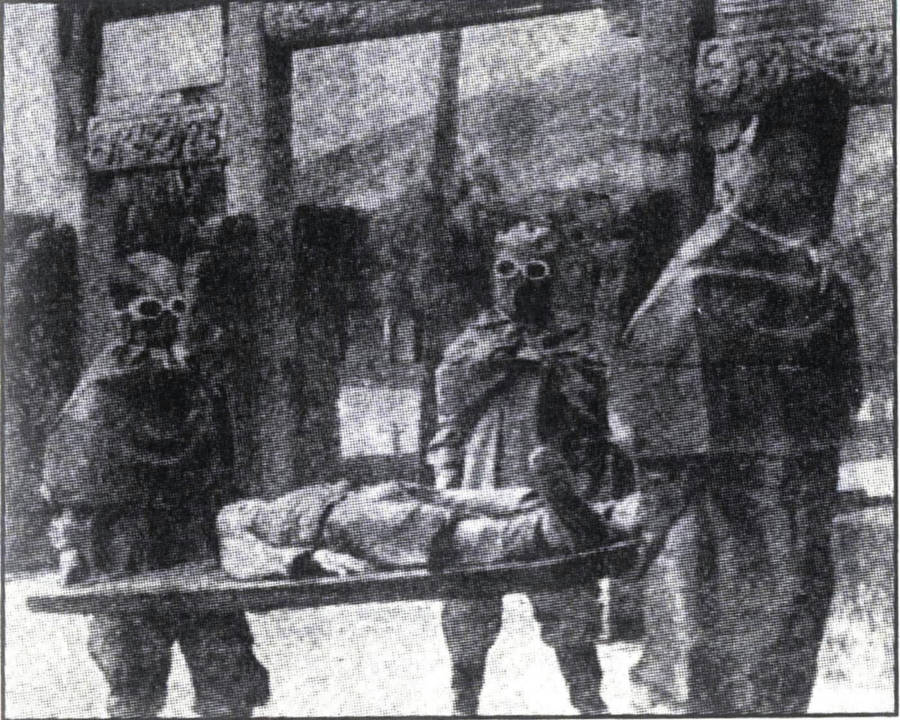
Xinhua via Getty Images Japanese personnel in protective suits carry a stretcher through Yiwu, China during Unit 731’s germ warfare tests. June 1942.
On October 4, 1940, Japanese bombers deployed these casings, each loaded with 30,000 fleas that had each sucked blood from a dying prisoner, over the Chinese village of Quzhou. Witnesses to the raid recall a fine reddish dust settling on surfaces all over town, followed by a rash of painful flea bites that afflicted nearly everyone.
From contemporary accounts, it is known that more than 2,000 civilians died of plague following this attack, and that another 1,000 or so died in nearby Yiwu after the plague was carried there by sick railway workers. Other attacks, using anthrax, killed approximately 6,000 more people in the area.
A few years later, as the war was nearing its end, Japan likewise planned to bomb America with plague-ridden fleas , but never got the chance. In August 1945, after Hiroshima and Nagasaki had both been bombed, the Soviet Army had invaded Manchuria and utterly annihilated the Japanese Army, and the emperor read his infamous surrender declaration over the radio, Unit 731 was officially disbanded.
Its records were mostly burned, destroying any useful information the team had managed to generate in 13 years of research. Researchers mostly slipped back into civilian life in occupied Japan as if nothing had ever happened, many of them becoming prominent members of university faculty.
To this day, Japan has not apologized for, and China has not forgiven, the countless atrocities Japanese forces visited upon China between 1931 and 1945 during the Second Sino-Japanese War and beyond. As the last witnesses to this history grow old and die, it’s possible that the matter will never be addressed again.
After this look at Unit 731, read up on some more of the worst war crimes ever committed as well as other Japanese war crimes from the World War II era. Then, have a look at four of the most evil science experiments ever performed and find out whether or not any of the highly disturbing Nazi research actually contributed anything to medical science .

PO Box 24091 Brooklyn, NY 11202-4091

35 Rare Images of the Infamous Japanese Experiment Unit 731 in China
Table of Contents
- 1 Japanese Experiment Unit 731: Rare Historical Images
- 2 What was the Unit 731
- 3.1.1 China Underground
Japanese Experiment Unit 731: Rare Historical Images
Unit 731 (731部隊), based in the Pingfang district of Harbin and led by the infamous Japanese microbiologist Shiro Ishii, was a covert biological warfare research and development unit of the Imperial Japanese Army that undertook human experimentation during the Second Sino-Japanese War (1937–1945) and World War II.
Featured image: A photograph released from Jilin Provincial Archives, which, according to Xinhua Press, “shows personnel of ‘Manchukuo’ attend a ‘plague prevention’ action which indeed is a bacteriological test directed by Japan’s ‘Unit 731’ in November 1940 at Nong’an County, northeast China’s Jilin Province.”
What was the Unit 731
At least 12,000 men, women, and children were killed during the experimentation conducted by Unit 731 at the camp based in Pingfang alone .
Related articles: Names of members of infamous Unit 731 released by the National Archives of Japan , Rare images of the infamous Japanese experiment unit 731 in China – Second Part – Graphic content – Men Behind the Sun by Mou Tun-Fei (The film is a graphic depiction of the war atrocities committed by the Japanese at Unit 731 )
Prisoners of war were subjected to a range of brutal experiments without anesthesia, including vivisection. Researchers infected detainees with various diseases before performing invasive surgeries to remove organs. This was done to study the effects of diseases on the human body, with the operations carried out on living subjects to avoid the impacts of decomposition on the results.

In a series of inhumane tests, humans were also used as live targets to assess the effectiveness of grenades, flamethrowers, and germ-releasing bombs, as well as chemical and explosive weapons. These prisoners were positioned at different distances and orientations to gauge the lethality of these weapons.
Shiro Ishii, a prominent figure in these experiments, oversaw the injection of prisoners with disease inoculations under the guise of vaccinations. This allowed scientists to observe the progression of diseases like syphilis and gonorrhea, which were deliberately transmitted to both male and female prisoners without treatment, to study their effects.
Additionally, to further research into germ warfare, prisoners were infested with fleas to produce large quantities of disease-carrying fleas. Techniques of warfare included dropping bombs filled with plague fleas, infected clothing, and other contaminated materials on various targets. The dissemination of cholera, anthrax, and plague through these means is estimated to have resulted in the deaths of approximately 400,000 Chinese civilians. Tularemia was another disease tested on Chinese civilians in these horrific experiments.
Unit 731 images
Related article: Japanese officer performing seppuku during World War II
Source : Wikipedia , incredibleimages4u.blogspot.com , picturechina.com.cn , enviromental graffiti , http://xubaojun.blog.163.com
Topic: causes of unit 731, what did they do at Unit 731
Post Author
China Underground
China-underground is website about China and Chinese culture.
See author's posts
Related posts:

Chinese students from the eighties vs 2012: 20 images
Shanghai as you’ve never seen it before: planet shanghai.
Enjoyed this post? Never miss out on future posts by following us
22 thoughts on “35 Rare Images of the Infamous Japanese Experiment Unit 731 in China”
We are a creation with the capacity to do great good and immense evil.
Today, Obama honors ww2 Japan…
That’s not wrong, in the end Japan suffered many casualties among the civilians…What we all should complain is the fact that americans didn’t punished many war criminals, like Shirō Ishii, the mastermind (or one of them) of the Unit 731. He died in 1959, and he didn’t pay for his crimes because americans wanted the data of the experiments! Of course the japanese government was guilty too, because they didn’t prosecute any of them. So OBama didn’t honor those war criminals, he honored the civil victims in Japan.
Did you know a lot of our modern medicine came from the findings of these experiments?
Maybe, but war criminals shoud pay for their crimes, if not with their lives, at least in some other ways.
What advances in modern medicine were advanced by these butchers? That I’d like to hear!!
It’s a long story. When you come in to an ER with extreme frostbite and they know exactly to treat you. They know exactly what frostbite does to the skin, tissues, etc. How it progresses and at what stage. Because of this information they could come up treatments. Where did they find out about the severe effects of frostbite? UNIT 731. Sad…but true. And this is just one example.
A lot of their experiments were to duplicate severe battle feild injuries. i.e. loss of limbs. Did you notice how much battle feild triage improved from WWII to the Korean War. Just 6 years seperate these two wars and yet medical surgical knowledge leaped for the MASH units. Where do you think this info came from?
What’re you talking about? Our modern medicine came from the findings of German experiments, not the Japanese.
The experiments were not done to save people in the future they were done to kill people in the most effective way. no noble goal just to make mass murder easy. The good came from doctors and scientists, who studied the craven acts
War Crimes are committed on both sides during War.
these are beyond “war crimes”… it is pure evil!
- Pingback: Não leia este texto se quer continuar achando o Japão fofinho bonzinho e injustiçado na 2a Guerra | Contraditorium
- Pingback: Bomber Command Museum to offer visitors immersive experience of – virtual reality news
I don’t know! do you? Do you have prove? they are researching to KILL, not to SAVE!!! Did you see the picture of all the naked kids? Any medicine worth that? Without humanity, what is left in life!!!
I’m sorry, but there’s absolutely no excuse, no justification that could justify what happened in Unit 731 and Unit 100. The cruelty and atrocity are beyond human understanding. I repeat THERE IS NO JUSTIFICATION WHATSOEVER for what took place in Harbin, China.
IT IS EVIL–SHEAR AND PURE EVIL. Shame to the Japanese who still try to cover it up or white wash their evil past !!!
im glad japan lost the war
It saddens me to hear this truth about the attrocities that were done in Unit 731. This is no different than in Germany. This is and was EVIL. I personally don’t care about the medical GAINS that have been achieved. Unfortunately EVERY EVIL has their way of justifying WHY they do what they do. Only GOD can forgive them. We must REMEMBER the reason WHY. Hitler; super race, Japanese; ??,. These days our younger generation only wants to whitewash the past. We are to learn from their past mistakes so they are NOT repeated.
everything about this point in time is a horror story. The really sad part of it all is China is literally doing things on this level in the name of organ transplants on demand as we speak today in 2020.
Are you people nuts, these VICTIMS are individuals with the exact same feelings of pain and terror and shock as you or I would experience, they probably had families and homes once, there is categorically no reason or excuse to put any human being through this kind of torture, I am utterly appalled and extremely upset by this atrocity and I believe that every one should be also, and as for medical knowledge we have found answers and treatments in ways that don’t destroy the profound right of every human to live and to live without being tortured
And by the way Crystal there is no such thing as supernatural beings, grow up
- Pingback: The Japanese did some heinous crap | Tales from the Conspiratum
- Pingback: A Brief History of Hong Kong Cinema, from 1909 to the present day
Leave a Reply Cancel reply
This site uses Akismet to reduce spam. Learn how your comment data is processed .
Please enter at least 3 characters
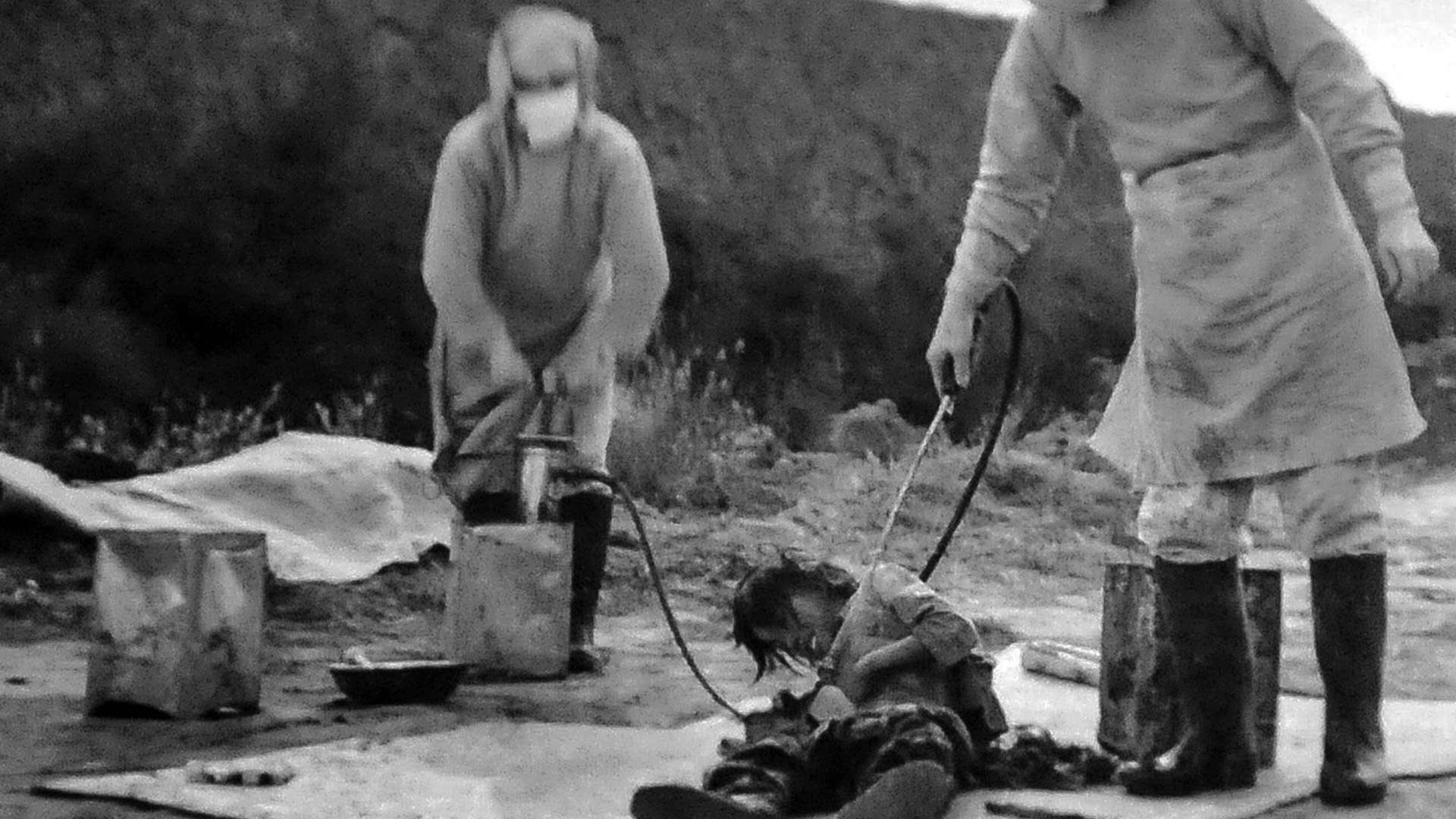
Japan’s Hellish Unit 731
In conquered Manchuria, ghastly experiments were fiendishly conducted on human guinea pigs.
This article appears in: Fall 2018
By David D. Barrett
The final months of World War II saw the liberation of hundreds of ghastly concentration camps and the awful reality of Nazi racism. For more than seven decades those atrocities, including the use of human beings for medical experiments, have been common knowledge. Far less known is the wholesale slaughter of hundreds of thousands of Chinese by a Japanese organization known as Unit 731.
Established for the purpose of developing biological and chemical weapons, Unit 731 exceeded by a year the duration of the Third Reich. While biological and chemical weapons were not new to warfare, Japanese testing on human subjects was unparalleled even by the Nazis.
What makes this descent into barbarity all the more stunning was the Japanese contribution to medical science just three decades earlier. A U.S. Army doctor named Lewis Livingston Seaman observed colleagues who were attending to the Imperial Japanese Army (IJA) during the Russo-Japanese War (1904-1905).
Dr. Seaman came away from his experience profoundly impressed with his medical brethren, stating, “The history of warfare for centuries has proven that in prolonged campaigns the first, or actual enemy, kills 20 percent of the total mortality in the conflict, whilst the second, or silent enemy (disease), kills 80 percent.
“I unhesitatingly assert that the greatest conquest of Japan has been in the humanities of war, in the stopping of the needless sacrifice of life through preventable disease. Japan is the first country in the world to recognize that the greatest enemy in war is not the opposing army, but a foe more treacherous and dangerous—preventable disease, as found lurking in every camp—whose fatalities in every great war of history have numbered from four to twenty times as many as those of mines, bullets, and shells.
“It is against this enemy that Japan, with triumphant exaltation, may cry Banzai. For it is against this enemy that she has attained her most signal victories….”
Twenty years later, Japan signed the Geneva Convention, which prohibited biological and chemical warfare. But where other men reasoned with justification that these kinds of weapons should be banned by civilized nations, another man, a specialist in bacteria and related fields, Dr. (Colonel) Shiro Ishii, saw the prohibition as an opportunity.
He reasoned that if something were bad enough to be outlawed, then it must certainly be effective, and he began a sustained effort to establish a military arm within the Japanese Army whose aim would be the development of weapons based on biology. Ishii was highly intelligent but arrogant, merciless, and immoral.
He thought of himself beyond reproach and as a visionary. He was driven to break new scientific ground and to help Japan defeat its foes. In his quest to contribute to that effort, Ishii in time exhorted his team of physicians to violate the physicians’ ethical code: “A doctor’s God-given mission is to challenge all varieties of disease-causing micro-organisms; to block all roads of intrusion into the human body; to annihilate all foreign matter resident in our bodies; and to devise the most expeditious treatment possible….
“However, the research we are now about to embark is the complete opposite of these principles, and may cause us some anguish as doctors. We pursue this research for the double medical thrill; as a scientist … probing to discover the truth in natural science; and as a military person, to build a powerful military weapon against the enemy.”
To convince the senior levels of the Imperial Army to back his efforts, Ishii built his case around financial considerations, completely skirting either Japan’s obligation to the world community as a signatory of the aforementioned 1925 Geneva Convention or the morality of using such weapons. Ishii argued that compared with the costs of building, manning, and maintaining huge conventional forces, bacteria and gas were a far less expensive alternative.
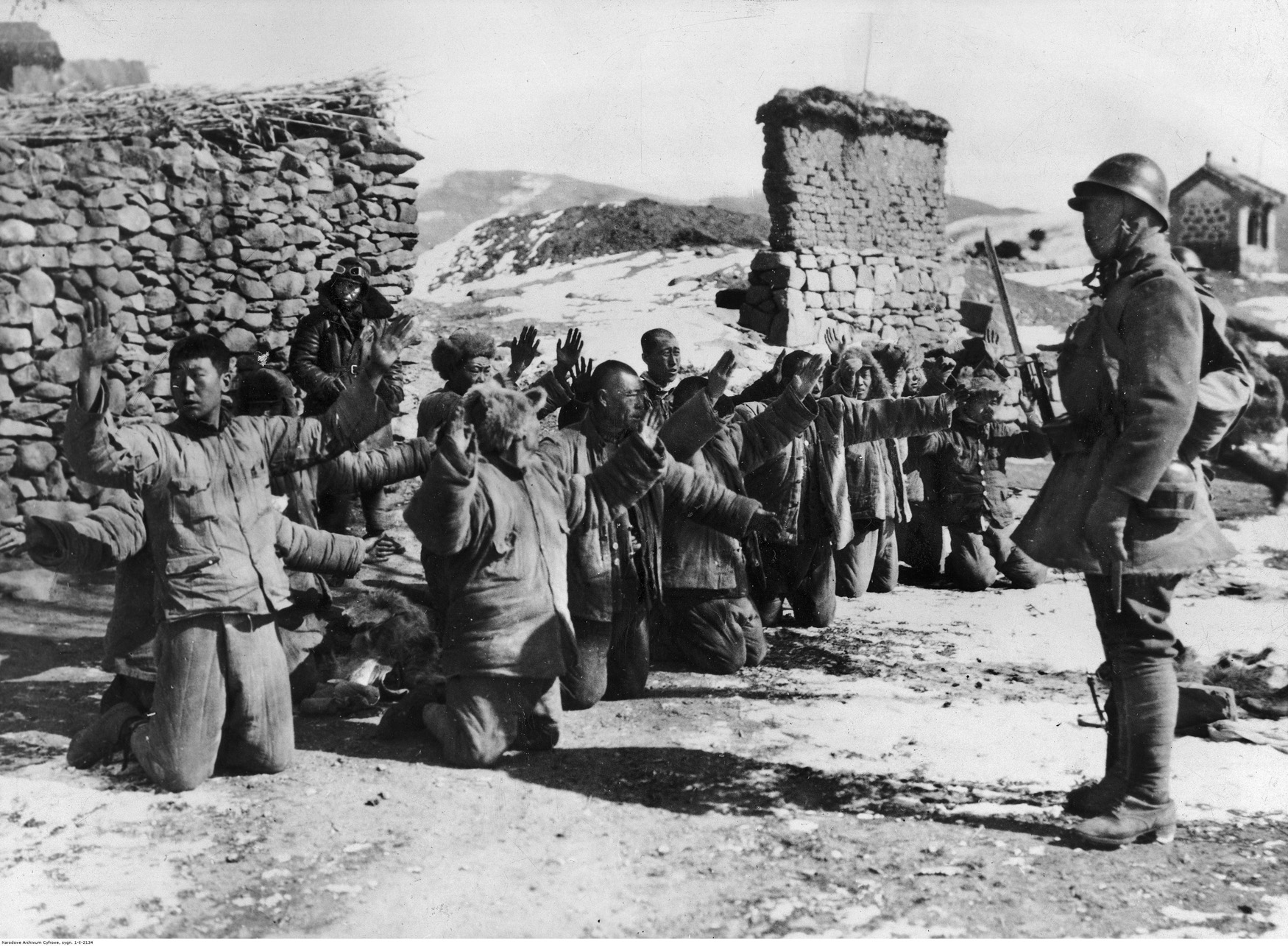
By 1930, nationalism burned hotter than ever in Japan and created a climate receptive to Ishii’s ideas of developing biological weapons. In September 1931, Japanese forces instigated the “Mukden Incident.” The pitched battle between Japanese and Chinese forces was actually no more than a Japanese ruse used to justify a complete takeover of Manchuria.
Moreover, the area became the perfect place to develop and test Ishii’s new biological and chemical weapons, a place where he would be free to conduct any kind of experiment he deemed beneficial.
The following year, under the cover of the euphemistically named Epidemic Prevention Research Laboratory, Ishii set up shop in the Army’s hospital in Tokyo. The location was only temporary because, to accomplish his objectives, he would need access to far greater resources; Japanese ascendancy in Manchuria provided its medical community unprecedented opportunities for research (much as the Germans used concentration camps and their prisoners for their own medical and pseudo-scientific research).
Ishii’s goal of turning bacteria and gas into weapons for the Imperial Japanese Army required comprehensive study, and he believed animals could not supply usable data. Japan’s control over Manchuria delivered research materials in the form of people who were plucked from the streets and locked into black vans known as voronki (ravens), to be carried off to the waiting prison cells of Unit 731.
Japan’s Kempeitai, the military police arm of the IJA from 1881 to 1945, was tasked with these kidnappings. The Kempeitai was less a conventional military police body than a secret police force akin to the Gestapo. Headed in Manchuria by Hideki Tojo, from 1935 to 1937, the Kempeitai’s cruelty was notorious in occupied territories. (See WWII Quarterly, Fall 2011). After the war, the U.S. Army estimated it numbered 36,000 regular members.
Anxious to take operations to the next level, in 1932 Dr. Ishii chose the city of Harbin, capital of Heilongjiang Province in southwest Manchuria, as the site of Unit 731’s first biological and chemical weapons facility. The original buildout covered a 500-square-meter area and was designated a restricted military zone. A tract of land to the south of the sector was appropriated and made into an airport. It and a nearby rail line were also used to move victims to Unit 731 and transport results and specimens back to Japan’s medical community.
Japan’s medical institutions enabled the work of Unit 731 by supplying Dr. Ishii with top Japanese scientists and physicians who would be labeled Hikokumin (traitors) if they refused to take part. Most medical professionals saw their work as noble service to the Emperor; the fact that they were killing non-Japanese meant nothing to them.
Unit 731 received state-of-the-art equipment and a nearly unlimited supply of funds from the Japanese government. Even for reluctant researchers Ishii’s factories were luxurious. The annual budget for Unit 731 was ten million yen (about nine billion yen in the modern currency, or about $86 million). Salaries were very generous, and the food was exceptional.
Precipitated by an escape attempt by 40 prisoners, all of whom were captured and killed, the Harbin operation was closed and moved to the Harbin suburb of Ping Fang in 1936. This complex was a sprawling walled city of more than 70 buildings that dwarfed its predecessor in Harbin. The perimeter at Ping Fang incorporated more than six square kilometers and rivaled Auschwitz-Birkenau in size. Tucked away inside the administration building was a prison that housed 500 men, women, and children selected for vivisection.
As immense as Ping Fang was, Unit 731 also had affiliated locations in Nanking (Unit 1644), Beijing (Unit 1855), and Changchun (Unit 100). Altogether there were 26 known killing laboratories, experimental detachments, and battalions of the Army spread across occupied lands in Asia. The total number of personnel involved reached some 20,000. All units and facilities were coordinated by the Epidemic Prevention Research Laboratory under the control of Colonel Ishii.
The research was made available not just to the Army hospital in Manchuria, but to doctors and educators throughout Japan. In this way, Unit 731 was performing the service of human experimentation for the entire Japanese medical community, in an on-going feedback loop. “Medicine itself must become a weapon,” said Nakagawa Yonezo, Professor Emeritus at Osaka University.
The gruesome professionalism of Unit 731 included a touch of sardonic humor. The construction of the Ping Fang installation prompted locals to ask what it was. The answer was a “lumber mill.” Regarding this reply, one of the researchers joked privately, “and the people are the logs.”
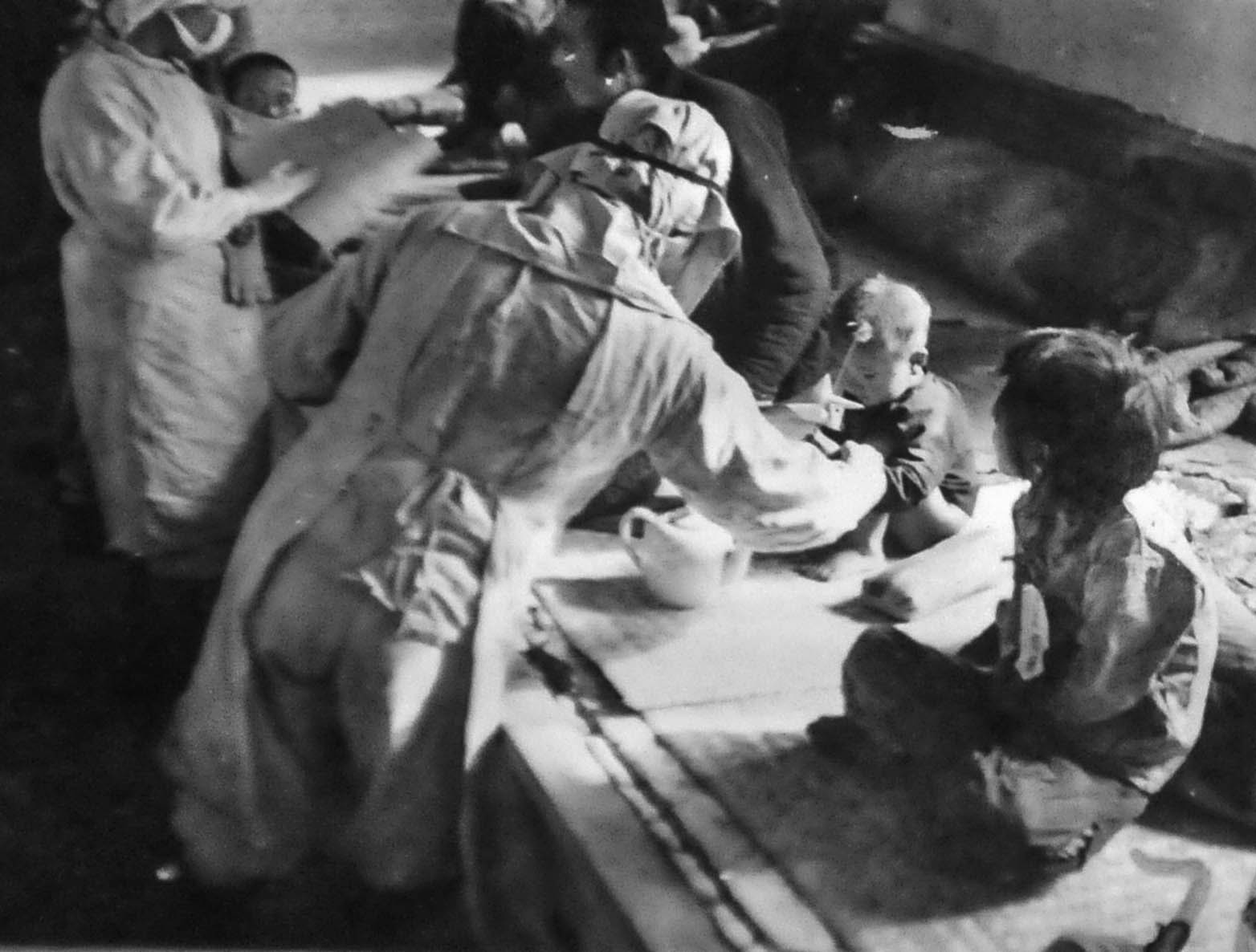
From then on, the Japanese term for log, Maruta, was used to speak of the prisoners whose last days were spent being infected with lethal pathogens, torn apart, frozen, or gassed by Japanese researchers. The expression indicates a degree of racism far beyond disdain; it is evidence of a belief that torturing the Chinese was of no more consequence than squashing a bug.
As noted earlier, the primary objective of Ishii and Unit 731 was the creation of biological and chemical weapons. To facilitate that end, wholesale human experimentation was utilized, including the vivisection of thousands of people. The justification for performing all these surgeries came from the expectation that human tests would create better weapons.
Doctors in Unit 731 examined the first stages of disease on organs. A former member of Unit 731 described the process: “As soon as symptoms were observed, the prisoners were taken from their cells and into the dissection room, he was stripped and placed on a table, screaming, trying to fight back. He was strapped down, still screaming frightfully. One of the doctors stuffed a towel into his mouth, then with one quick slice of the scalpel he was opened up.” Witnesses reported that, without anesthesia, the victims let out horrible screams when the first cut was made and that the cries stopped soon thereafter.
A doctor at Ping Fang testified to a time when he was working on a pregnant female victim who awoke from anesthesia while being vivisected. The woman said, “It’s all right to kill me, but please spare my child’s life.” It is likely that more than one mother voiced, as a last wish on the vivisection table, the wish to let her child live. None ever did. The researchers wanted their data.
As ghastly as these procedures were, vivisections were not limited to weapons development, but fell into four categories: (1) intentional infection of diseases, (2) training newly employed army surgeons, (3) trials of nonstandardized treatments, and (4) discovering the limits of human tolerance to pain and stress.
Under the auspices of weapons development and intentional infection of diseases, prisoners were injected with various biological agents including plague, typhus, cholera, anthrax, and syphilis.
To test the effectiveness of dispersion methods for military purposes, victims were staked to crosses with their vital organs and heads protected. Various types of bombs and agents were then dropped or sprayed from specially modified planes to test the survivability of the agents and their ability to infect the subjects. Community water and food sources were also contaminated. To determine the results, mobile vivisection units were set up in the field near the infected communities.
The Imperial Japanese Army also allowed its physicians to perform vivisections on living subjects to train them in the treatment of battle wounds—procedures that are too gruesome to describe in detail.
Tests that could have real medical value were also conducted, such as finding the best method to deal with frostbite. But even here Japanese doctors chose to perform the experiments in the most merciless ways possible.
Conventional weapons tests were also carried out. Victims were tied to stakes and used to determine the operational range of flamethrowers, grenades, and various kinds of shells and bombs.
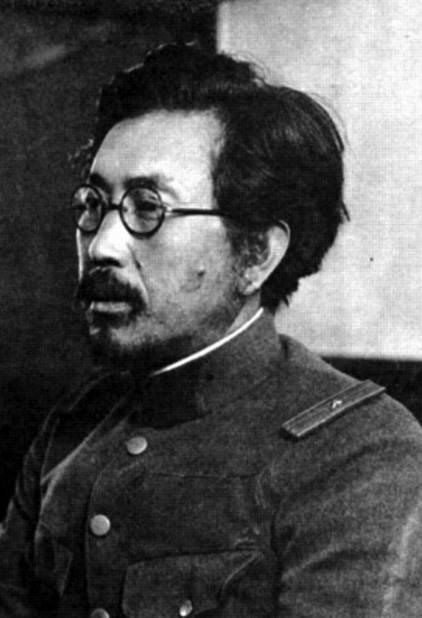
But this was hardly the extent of the tests to which the prisoners were subjected. Sheldon Harris, author of Factories of Death, stated, “They just killed people with no inherent purpose other than to see how they reacted to being killed.” People were locked into high-pressure chambers until their eyes popped out, or they were put into centrifuges and spun to death.
Other experiments involved hanging prisoners upside down to discover how long it took for them to choke to death or injecting air into their arteries to test for the onset of embolisms. Another test consisted of taking blood samples, at least 500 cm³ (slightly more than a pint) at two- to three-day intervals. Some victims became debilitated; still, the blood drainage continued.
When the human guinea pigs could no longer serve as lab material, they were abused in various manners: injected with poison, killed for their vital organs (brains, lungs, or liver), subjected to violent surgeries (e.g., amputation and reattachment of the limbs to the opposite sides of the body, resection of the stomach to attach the esophagus to the intestines). Electrical shocks were administered until the person slowly roasted to death.
Some experiments had no medical purpose whatsoever except the administering of indescribable pain, such as injecting horse urine into prisoners’ kidneys. The doctors of Unit 731, like the Nazi doctors at Dachau and Buchenwald, indulged any perversion they could imagine.
In 1938 and 1939, the Soviet and Japanese Armies clashed in two encounters near the border of Mongolia and Manchuria. The 1939 summer battle, known as the Nomonhan Incident and the Battle of Kalhin Gol by the Soviets, resulted in the overwhelming defeat of the Japanese Kwantung Army by Stalin’s Red Army.
The clash saw the first field operation of Japan’s biological warfare unit; it occurred in a desert region where water was scarce. To disable their Russian foes, the Japanese dumped large quantities of intestinal typhoid bacteria into the river.
Fortunately for the Russians, this type of typhoid germ became ineffective almost immediately after hitting the water. The contamination was probably initiated more for the publicity than anything else, as Ishii likely knew it would not work.
In 1940, Japanese planes dropped wheat, corn, rags, and cotton infested with bubonic plague on the unarmed village of Ningbo, China. More than 100 people died within a few days of the attack.
Two years later, the Japanese conducted a second attack in the same area. Japanese researchers took over a house on top of a hill about a kilometer away from the infected zone to use as a vivisection laboratory. As a result of the attacks, the Ningbo region remained sealed off until the 1960s.
During the siege of Bataan in the Philippines in March 1942, the Japanese planned to release 200 pounds of plague-carrying fleas—about 150 million insects—in each of 10 separate attacks. However, by the time the assault was ready the battle had already ended.
In June-July 1944, during the Battle of Saipan, plague-infested fleas were again to be used against U.S. forces. Fortuitously for the Americans, by this stage in the war it had become almost impossible for the Japanese to get any reinforcements and or matériel to its island bastions, and the Japanese submarine carrying the fleas was sunk en route.
For the Battle of Iwo Jima, February-March 1945, another biological attack was to be carried out against the invading Americans. Two gliders loaded with pathogens were to be towed over the battlefield and released. The gliders never reached their destination.
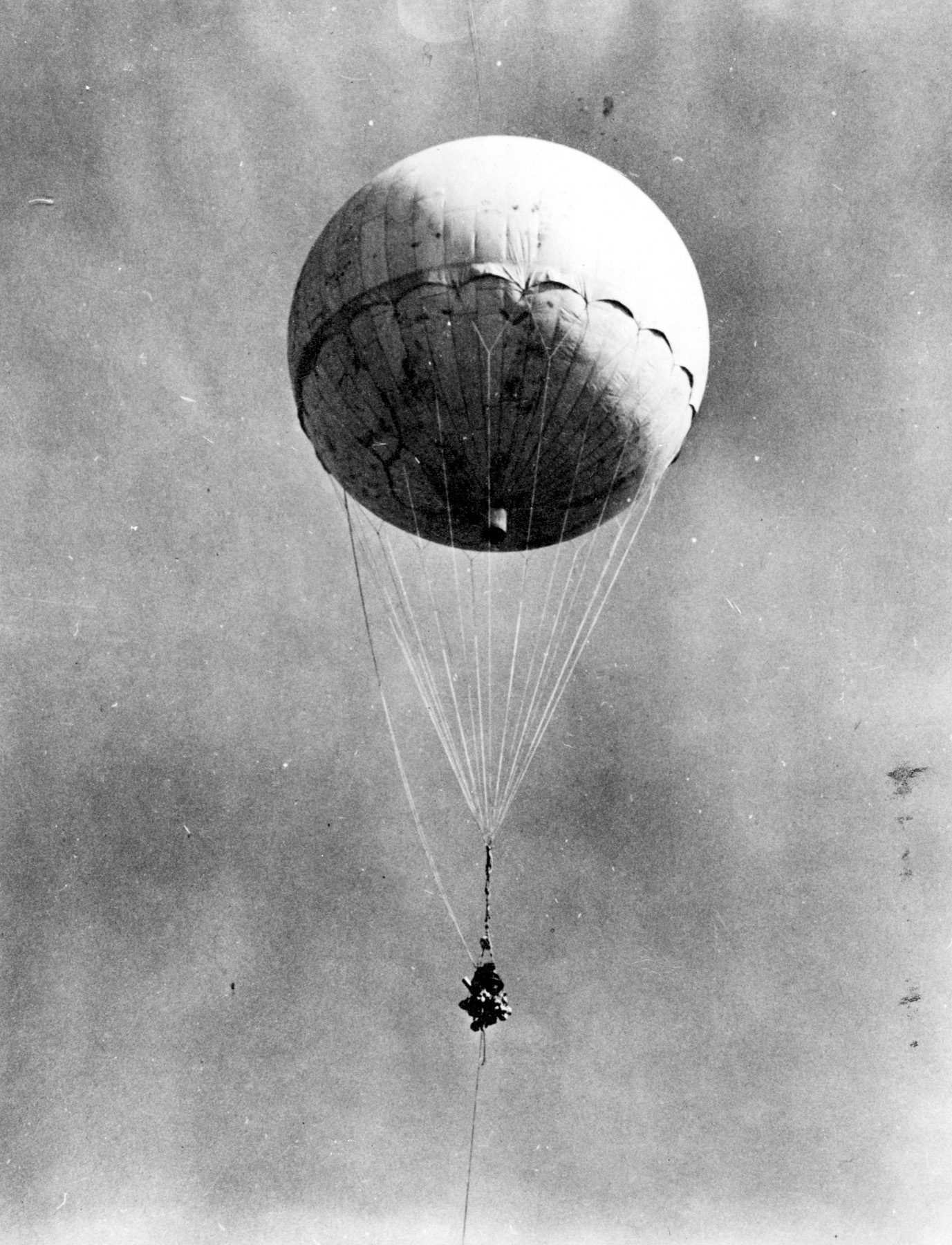
One of the least known Japanese efforts to attack Canada and the continental United States occurred in late 1944 and the spring of 1945. Records uncovered in Japan after the war indicated that about 9,000 balloon bombs, known as fugo, and carrying incendiary bombs, were launched into the jet stream during this period. More than 200 ultimately reached the United States. Six people were killed in Oregon when a bomb detonated on discovery. Before Japan surrendered, Ishii and Army leaders proposed using balloon bombs filled with cattle plague and anthrax.
As part of Japan’s defense of Okinawa in the spring of 1945, Unit 731 had developed plans to meet the American invaders with plague bacteria. The attacks were never carried out because once again fleas carrying the plague could not be delivered to the island. The native Okinawan population only learned of this plan in 1994.
Operation PX, aka Cherry Blossoms at Night, were the codenames for the Japanese plan for a biological attack on cities in southern California. The plan was completed March 26, 1945, and scheduled for September 22, 1945, but was abandoned due to the strong opposition of Army Chief of Staff General Yoshijiro Umezu, who was also a member of Prime Minister Suzuki’s war cabinet.
The plan involved the use of five I-400 submarine aircraft carriers, each carrying three Aichi M6A Seiran floatplanes launched against San Diego, Los Angeles, and/or San Francisco. The aircraft were to spread bubonic plague, cholera, typhus, and dengue fever over the city, while the submarine crews infected themselves and ran ashore in a vast suicide mission.
Even after surrender, the Japanese considered a final use of biological weapons. Ishii wanted to stage suicide germ attacks against occupying U.S. troops in Japan. This planned attack never took place, once again due to opposition from General Umezu and Vice Chief of the Imperial Japanese Army General Staff, General Torashiro Kawabe, who claimed that he did not want Ishii to die in a suicide attack.
Almost as soon at World War II ended, a new Cold War began between the United States and the Soviet Union. In this atmosphere, Lt. Col. Murray Sanders of the United States Army recommended to General Douglas MacArthur and President Harry Truman in the fall of 1945 that Ishii and his subordinates be given immunity from prosecution as war criminals in return for Unit 731’s research.
MacArthur and Truman approved the deal, and Japan’s biological and chemical weapons program remained largely a secret until the 1990s.
From start to finish, the highest levels of the Japanese government and military were involved in Unit 731. Hideki Tojo, head of the Kempeitai in Manchuria from 1935 to 1937, became Japan’s longest serving prime minister in World War II, from October 18, 1941, to July 22, 1944. Tojo approved the attack on Pearl Harbor and was tried as a Class A war criminal and hanged in 1948.
General Yoshijiro Umezu, who served as the Army’s chief of staff, was a member of the elite war cabinet that held the reins of power in Japan from April 1945 until it surrendered to Allied forces on September 2, 1945. According to Lt. Gen. Kajitsuka Ryuji of the Japanese Medical Service and former Chief of the Medical Administration for the massive Kwantung Army (located in Manchuria), Ishii was given permission to begin the Ping Fang experiment in 1936 by “command of the Emperor.”
At some point in 1939-1940, Hirohito issued still another decree recognizing Ishii’s unit for its service. Moreover, the Emperor’s younger brother toured Unit 731’s facilities during its time of operation.
Unit 731 was extremely well funded, with state-of-the-art facilities, generously staffed with the cream of Japan’s medical community, and routinely communicated with the medical establishment back in Japan—which even provided suggestions for experiments and regularly received human samples.
The vast majority of Ishii’s staff walked away from their wartime service scot free. Information turned over to the United States proved worthless to the American biological weapons program, as the vivisection of human beings did not yield better scientific data.

Immune from prosecution as war criminals, many of Unit 731’s doctors went on to prominent careers in universities, hospitals, and industry, rising to positions that included governor of Tokyo, president of the Japanese Medical Association, and head of the Japanese Olympic Committee. The ringleader, Dr. Shiro Ishii, quietly returned to private practice and died in 1959 of throat cancer at the age of 67.
The Soviet Union was the only government to bring anyone associated with Unit 731 to trial. In late December 1949, in Khabarovsk, Russia, 12 former physicians, officers, and staff were accused of manufacturing biological and chemical weapons. While there was some coverage in the American press, the United States government, keen on protecting its secret deal, labeled the proceedings just another Soviet show trial.
It would take nearly 50 years before the infamy of Unit 731 came to light in the United States. Unlike the Nuremberg and Tokyo trials, in which high-ranking German and Japanese officials were hanged or sentenced to life in prison, the Khabarovsk trials saw no sentence exceed 25 years—with some as short as two. All of the defendants were quietly freed and slipped back to Japan by 1956.
In 1998, more than 100 Chinese plaintiffs filed suit in Japan in an effort to get the Japanese government to acknowledge the crimes of Unit 731 and to obtain reparations for the victims and their families. Mere months before the trial began, the Japanese Education Ministry approved a textbook glossing over the Imperial Japanese Army’s culpability.
The Tokyo District Court’s ruling, coming on August 28, 2002, accepted that Unit 731 had waged germ warfare in China and caused harm to residents but dismissed the Chinese plaintiffs’ claim for compensation. Nevertheless, it was the first time a Japanese court admitted that the Imperial Army had used biological weapons during its war with China from 1932-1945.
Judge Iwata said in handing down the ruling, “The evidence shows that Japanese troops, including those from Unit 731, used bacteriological weapons under the order of the Imperial Japanese Army’s headquarters and that many local residents died.” Noteworthy in the judge’s declaration was his understatement that “many local residents died.”
The judge’s comment was, however, consistent with much of the narrative written about Unit 731 after the war, which generally characterizes the group’s activities as “experimental,” a seeming reference to the vivisections conducted by the Japanese doctors.
Most accounts reckon the loss of life caused by vivisection to be around 3,000 to 10,000 individuals. These figures neglect the field tests of pathogens conducted against Chinese civilians and the subsequent losses of life from bubonic plague after the war.
Such minimization constitutes a miscarriage of justice for the hundreds of thousands who were murdered as a result of these attacks, and potentially the tens of thousands more Americans who could have died if the Japanese plans had been carried out on numerous Pacific battlefields, or if they had been successful in their attempts to deliver biological agents to the U.S. mainland in the latter stages of the war.
As it stands, Sheldon Harris’s Factories of Death (1994) estimates the loss of life at 200,000, with Daniel Barenblatt’s A Plague Upon Humanity (2008) putting it as high as 580,000.
At what point is Unit 731 indicted for mass murder? While some Japanese scholars have been rigorous in documenting Japan’s war crimes, their own government has been unwilling to acknowledge the atrocities it perpetrated against China.
Unit 731’s legacy is one of a useless, fanciful, extravagant, and sadistic indulgence that accomplished nothing politically or militarily for Japan, and, in terms of its research, nothing for the United States.
One can only hope that the perpetrators, who escaped prosecution as war criminals, achieved something positive in their postwar careers because the victims are still crying out for justice.
Back to the issue this appears in
Join The Conversation
Leave a reply cancel reply.
You must be logged in to post a comment.
Share This Article
- via= " class="share-btn twitter">
Related Articles
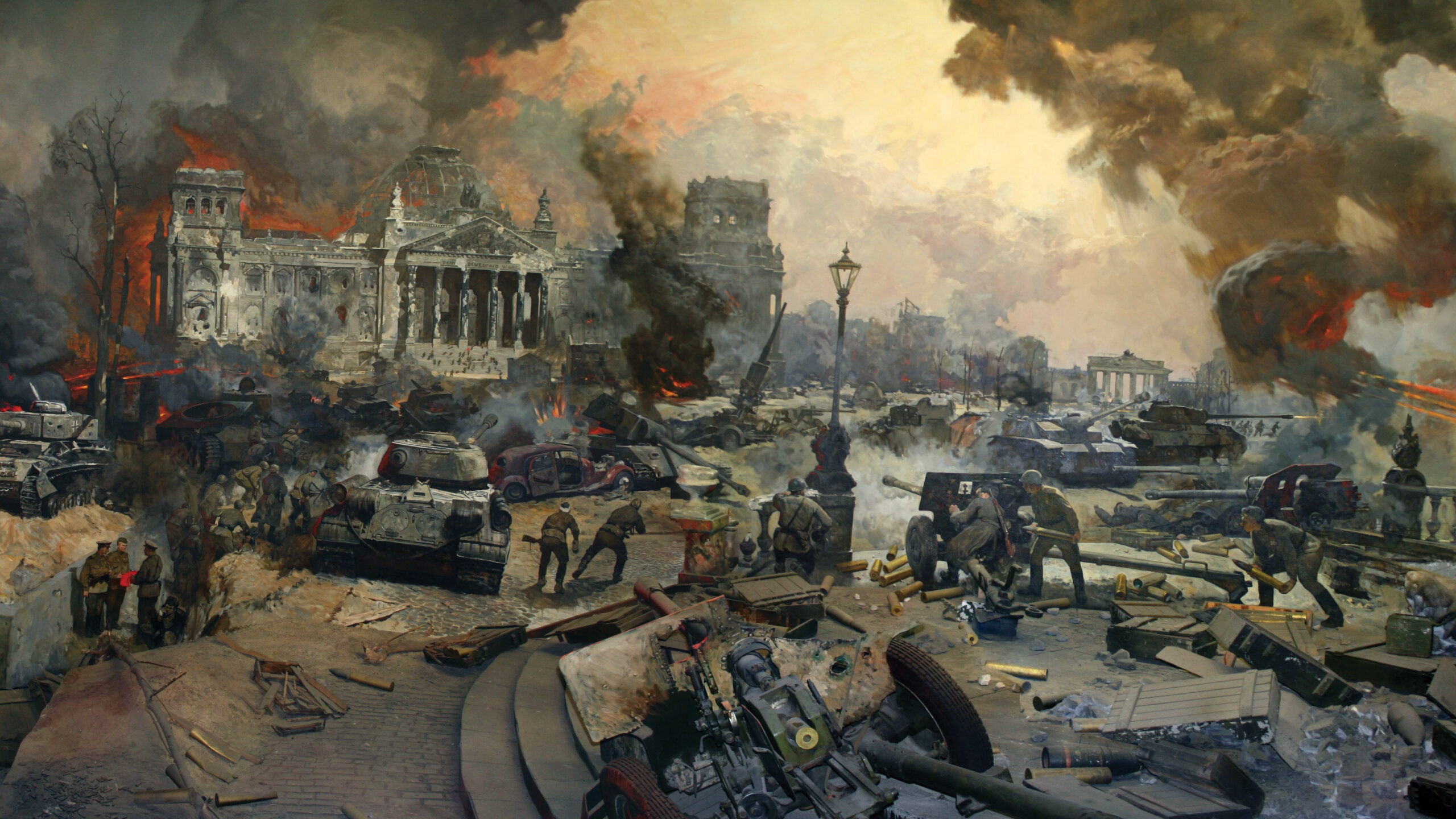

Battle of Berlin: Why it Became the Death Knell for Hitler’s Third Reich
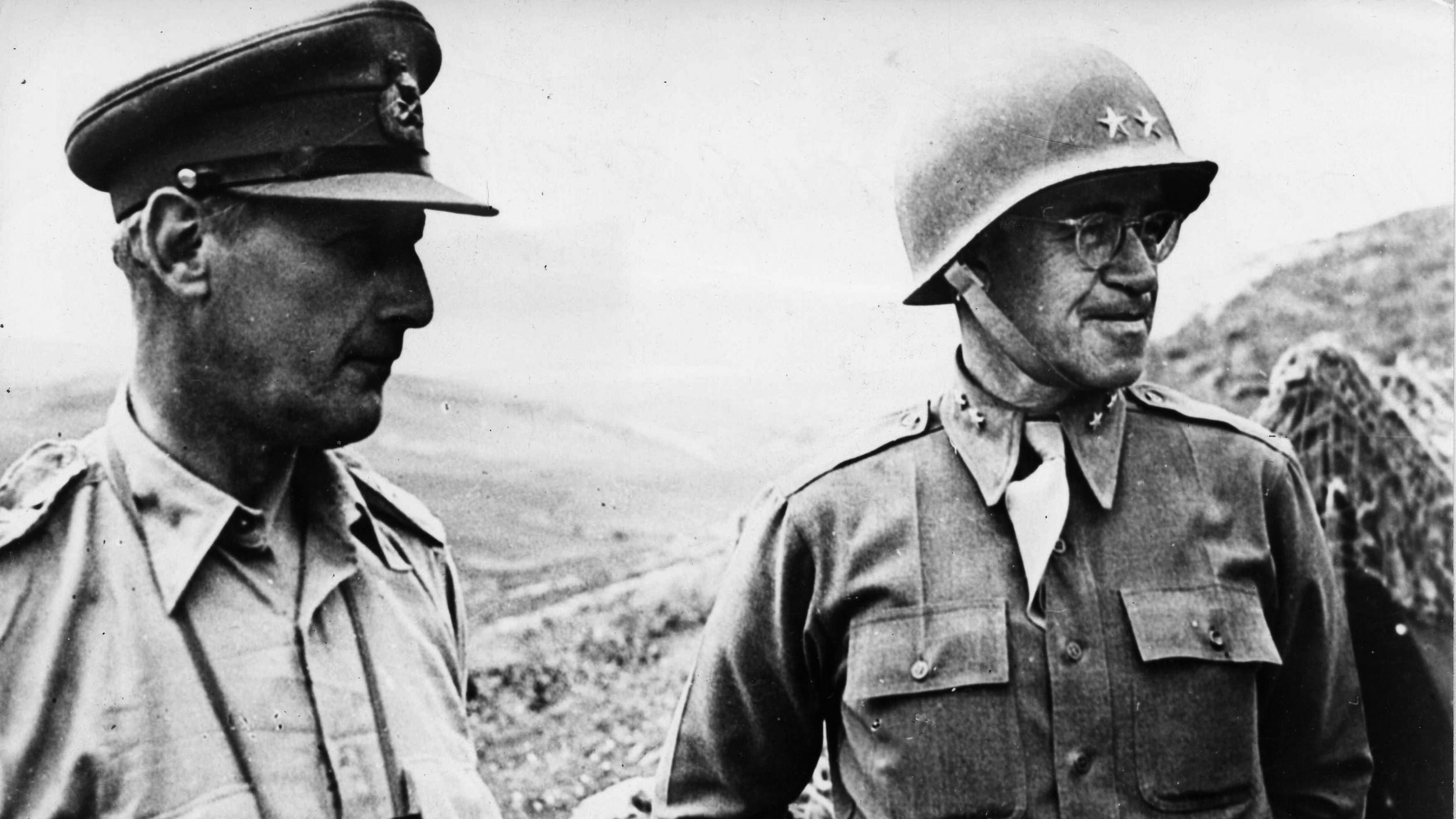
General Omar Bradley: Dwight D Eisenhower’s Indispensible Lieutenant
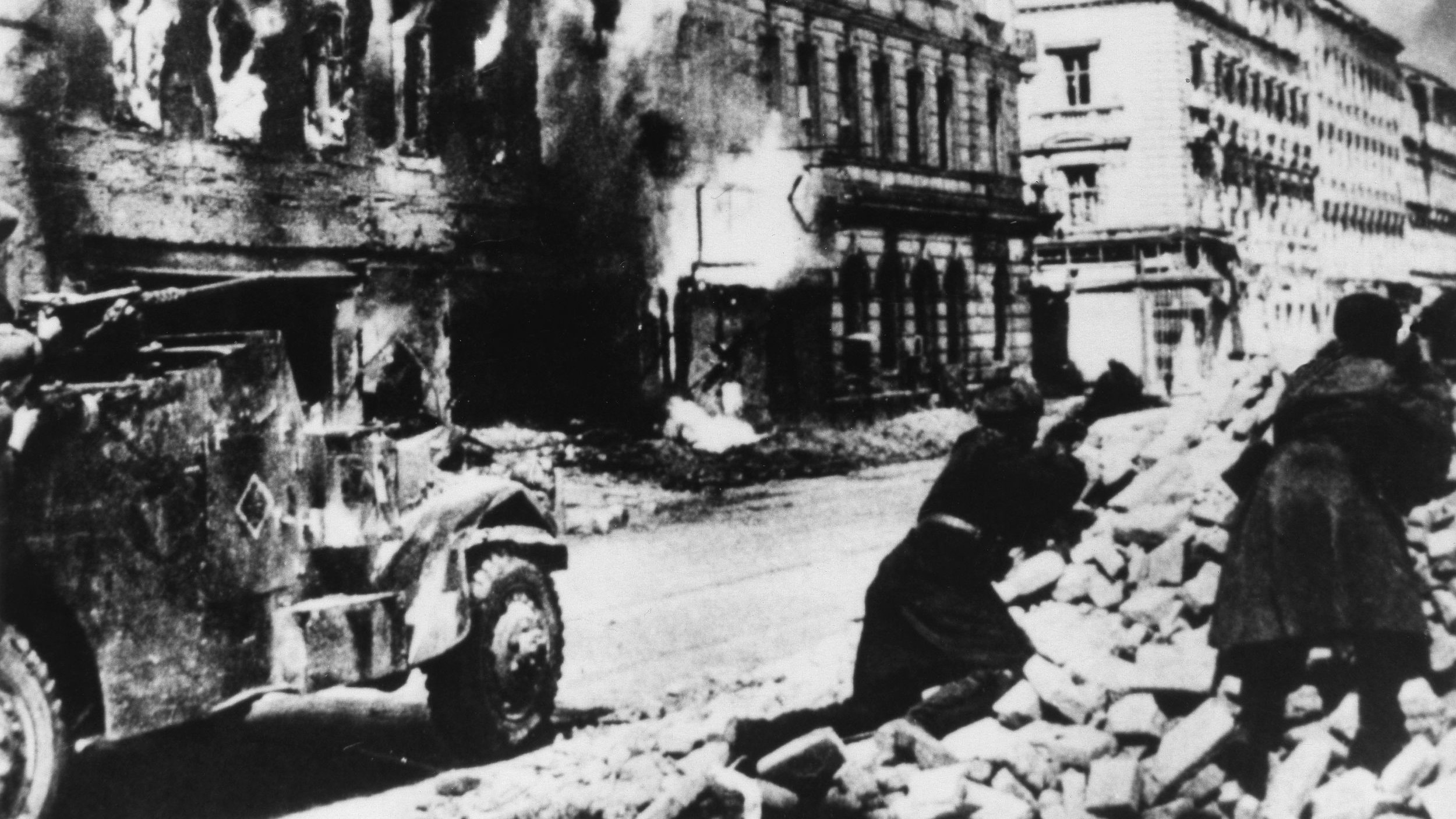
A Soviet Red Army Victory at Vienna
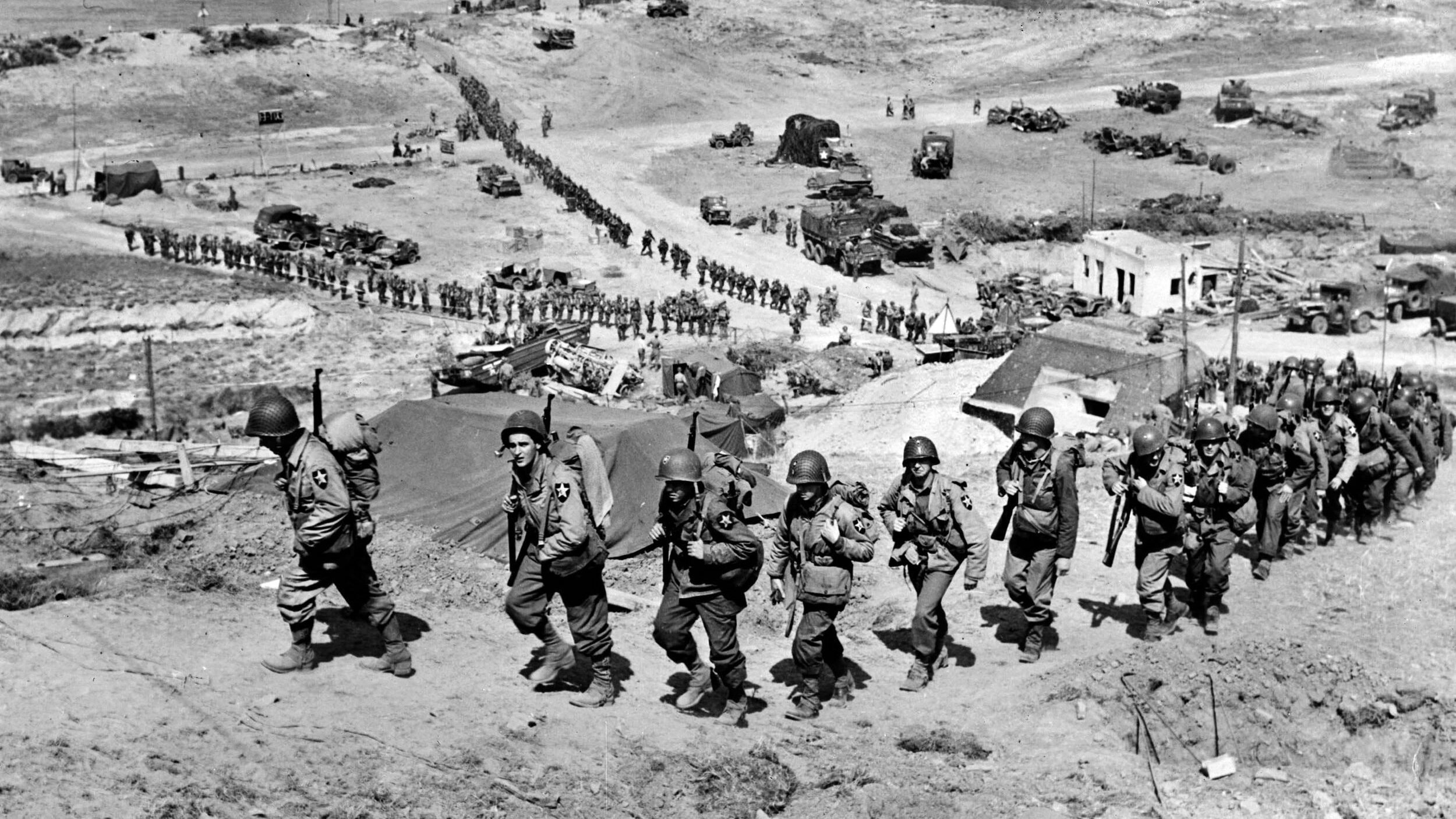
Up through the Ranks
From around the network.

Book Reviews
Eric G. Pinzelli’s ‘Masters of Warfare’

Military Games
World of Warships
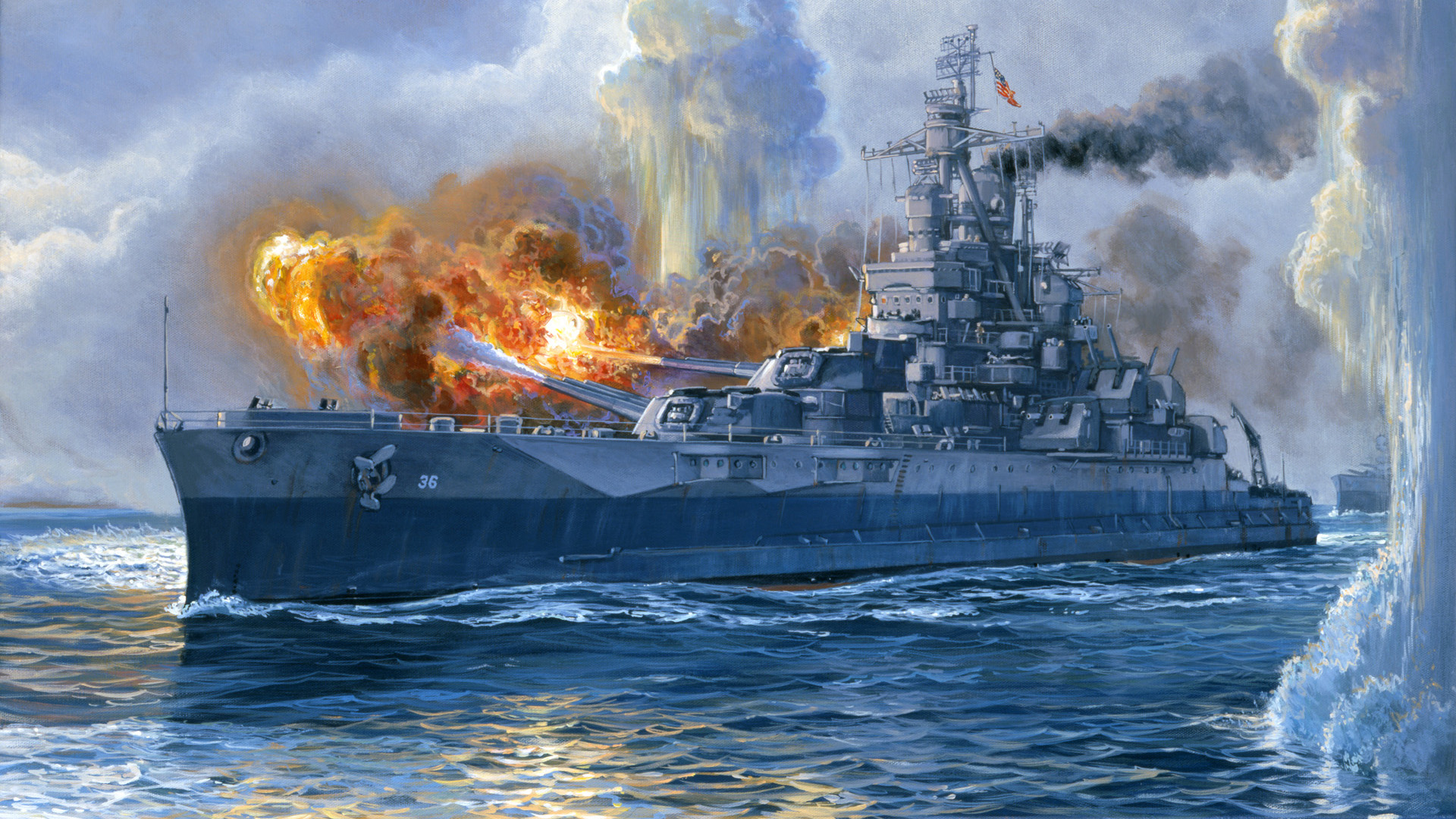
The Nevada and I Survived the War

Ultimate General: Civil War

Unit 731: Japan's Secret Horrifying Human Experiments

- Share on Facebook F
- Share on Twitter L
- Share on LinkedIn I
- Subscribe to RSS R
Unit 731 didn’t prevent epidemics—it spread them.
Japan has gone down in popular memory as the original victim of weapons of mass destruction, after the U.S. dropped atomic bombs on Hiroshima and Nagasaki in August 1945.
But it was China that was the real first victim of WMDs in World War II—and the perpetrator was Japan itself. Tokyo’s biological weapons killed hundreds of thousands of Chinese. And their murders still matter today.
But Imperial Japan had no such fear because backward China had no WMDs and no other means of massive retaliation. Moreover, Tokyo viewed the Chinese as a racially inferior enemy—one that foolishly resisted a massive Japanese army that tried for nearly a decade to subdue China.
Bio-warfare seemed one way out of China’s unseemly quagmire.
Unit 731 , Japan’s biological warfare program, was formed in 1932 under the leadership of the notorious Gen. Shiro Ishii, chief medical officer of the Japanese army. Based in Japanese-occupied Manchuria, Unit 731 operated under the cover name “Epidemic Prevention and Water Purification Department of the Kwantung Army.”
But Unit 731 didn’t prevent epidemics—it spread them. Nazi medical experiments on concentration camp prisoners, performed by monsters such as Josef Mengele, have been thoroughly documented.
Less well known are the experiments that Japan performed on adult male Chinese prisoners of war and political prisoners, as well as women and children. The captives were injected with diseases such as cholera and gonorrhea, or chained to stakes while aircraft dropped plague bombs.
There was also the vivisection. “Human experimentation gave researchers their first chance to actually examine the organs of a living person at will to see the progress of a disease,” according to Hal Gold’s book Unit 731 Testimony .
“Vivisection was a new experience for the doctors of Japan,” Gold writes. “One former unit member explained that ‘the results of the effects of infection cannot be obtained accurately once the person dies because putrefactive bacteria set in. Putrefactive bacteria are stronger than plague germs. So, for obtaining accurate results, it is important whether the subject is alive or not.’”
As atrocities go, or as much as sane human beings can rank them, this doesn’t sound any worse than Nazi experiments. But unlike the Nazis, Imperial Japan actually weaponized its biological horrors.
Cholera was dumped into wells used by the Chinese populace. Fleas were carefully collected, infected with plague and then dropped in aerial bombs over Chinese cities and villages .
“The air team and those who knew how to handle bacteria would get into a plane together and spread germs over a village or other areas of population concentration,” said a Unit 731 member cited in Gold's book. “After that, the area would be examined for the effectiveness of the attack.”
“With plague, fleas were used as a carrier and transported in a ceramic bomb,” the unit member added. “At first, glass bombs were tried, but they did not work well. Rats weigh about 600 grams. They were infected with plague, then they were infested with 3,000 to 6,000 fleas each and loaded into the ceramic bomb. When the bomb is dropped and breaks, the fleas scatter.”
Half a million or more Chinese died in these attacks.
It would be satisfying to say that the perpetrators of Unit 731 were punished for their crimes. But there’s no happy ending here. In 1945, Ishii and the other members of Unit 731 made a deal with Gen. Douglas MacArthur and the U.S. government: they would turn over their research to the Americans—not the Soviets—in return for immunity from prosecution.
Even compared to the sordid dealings that allowed Nazi scientists and spies to trade their expertise for immunity from war crimes trials, this was repugnant.
Some might dismiss Japan’s bio-war against China as history from a past century. But that history still resonates. Memories of Japanese atrocities still linger in Asia. And as China and Japan appear on the brink of conflict over disputed islands in the East China Sea, it’s worth remembering that this time, it’s China and not Japan that has weapons of mass destruction.
Should Chinese ever contemplate the use of nuclear weapons against Japan, you can be sure the ghosts of Unit 731 will be at their side.
Image : Wikimedia Commons.
Advertisement
Inside Unit 731, Japan's Gruesome WWII Human Experiment Program
- Share Content on Facebook
- Share Content on LinkedIn
- Share Content on Flipboard
- Share Content on Reddit
- Share Content via Email

Key Takeaways
- Unit 731, a Japanese Imperial Army program, conducted deadly medical experiments and biological weapons testing on Chinese civilians during WWII.
- Thousands of prisoners were killed in cruel experiments, and perhaps hundreds of thousands more died from biological weapons testing.
- The true extent of Unit 731's actions was shielded from public knowledge for years, with the U.S. granting immunity to top officials in exchange for research.
For years after World War II , in most of what was considered the "civilized" world, the truth behind Japanese Imperial Army Unit 731 was quietly swept away. Facts were suppressed. Memories questioned. Reports denied.
Even today, the true extent of Unit 731's wartime actions — horrendous, deadly medical experiments and lethal biological weapons testing on unsuspecting Chinese civilians — is known largely only to historians and scholars.
But the facts are out there for those who seek them. And for those who seek to use them for their own personal reasons.
"I think that it has become a piece of this tortured dialogue over the war between Japan and China. The Chinese have seized upon this quite a bit. And the Japanese right, the nationalist right, their basic view is that, 'Oh, the Chinese. This is all political.' ... And there is a certain truth to that," says Daniel Sneider , a lecturer in international policy at Stanford's Freeman Spogli Institute for International Studies . "There is a 'uses of the past' question here. Perhaps you could say it's cynical in that everybody does it."
The truth is that Japan's Unit 731 committed some of the most heinous war crimes ever. Thousands of prisoners were killed in cruel human experiments at Unit 731, which was based near the northeastern China city of Harbin, north of the Korean peninsula and on a border with Russia. Perhaps hundreds of thousands more — maybe as many as a half-million — were killed when the Japanese tested their biological weapons on Chinese civilians.
The exact number of dead is not known. It may never be known.
"It's very difficult to calculate," says Yue-Him Tam , a history professor at Minnesota's Macalester College and co-author of a book entitled, " Unit 731: Laboratory of the Devil, Auschwitz of the East (Japanese Biological Warfare in China 1933-1945) ." Tam, born and raised in China, has taught a class at Macalester on war crimes and memory in contemporary East Asia for more than 20 years. "If you include those victims who suffered from the other activities — not necessarily just used as human guinea pigs — the bombs in China ... it's very difficult to calculate."

The Start of Unit 731
America's shameful part, dealing with unit 731 today.
Unit 731 — its official name was the Epidemic Prevention and Water Purification Department of the Kwantung Army — was formed before World War II began (at least for the U.S., which didn't officially enter the war until December 1941). It came about sometime in the mid-1930s when Japan and China went to war , a conflict that eventually morphed into World War II's war in the Pacific theater.
The Unit's charge was clear from the beginning: testing, producing and storing biological weapons. Such activities were outlawed by at least two international treaties at the time, though the Japanese did not ratify the 1925 Geneva protocol . It didn't matter.
From the start, Unit 731, under General Shirō Ishii , was merciless.
Among the thousands of experiments conducted on prisoners: vivisections without anesthesia; injections of venereal diseases to examine their spread; amputations to study blood loss; removal of other body parts and organs; starvation; and deliberate exposure to freezing temperatures to examine the effects of frostbite . From a 1995 article in The New York Times , relating a story from a medical assistant in Unit 731:
Reportedly, not one of the thousands of prisoners that were experimented on — most of whom were Chinese, though many were Russian or Korean — survived.
Later, the Japanese took especially virulent forms of the plague and other pathogens that were developed at Unit 731, put them in canisters and dropped them on nearby towns to see if their weapons would work. They did.
Thousands of these still-dangerous bombs remain in the Chinese countryside today, Tam says. Some people still suffer from the Japanese "dirty" bombs.
At one time, the Japanese hatched a plan to infect fleas with a plague manufactured at Unit 731 and drop flea-filled bombs, launched from planes stored aboard submarines, on San Diego in a mission code-named Operations Cherry Blossoms at Night . The war ended before the plan could be executed.
After the U.S. dropped atomic bombs on Japan and effectively ended the war in 1945, Japanese leaders ordered the destruction of Unit 731, which included more than 150 buildings and two airports. As the victorious Allied forces approached, many hundreds of remaining prisoners were killed. The thousands of people who worked in the place and conducted experiments on healthy, living humans scattered, many never to face justice.
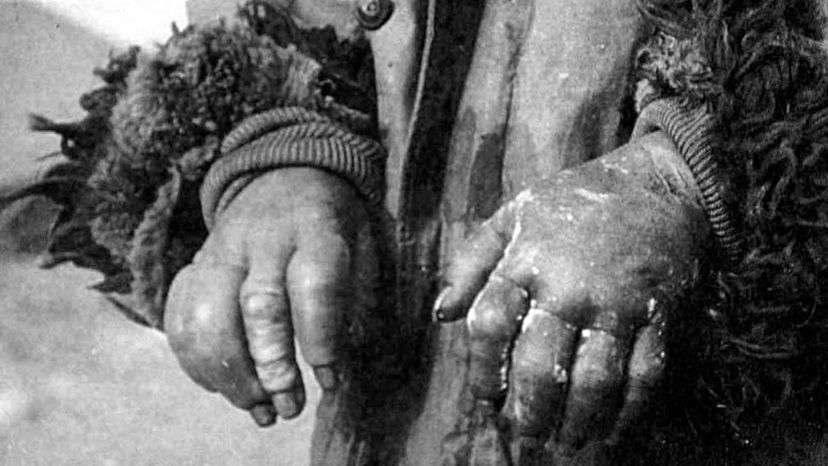
The top doctors and soldiers at Unit 731 kept careful records of their experiments, and used them to leverage their way to freedom after the war. When the Allies swept into China, they agreed to grant Ishii and many of his associates immunity from prosecution for war crimes . The reasons: The U.S. wanted Unit 731's research for its own use , and it wanted to keep that information out of the hands of others, including the Russians. Thus, for years, the true nature of what went on in Unit 731 was shielded from public knowledge.
Some of the truth came out in the Khabarovsk War Crimes Trial , held in that Russian city in December 1949. Twelve members of Unit 731 and associated units were tried. All were found guilty and imprisoned. Despite that trial, though, much of what went on in Harbin was immediately classified by the U.S. government and remained clouded in secrecy.
More details about Unit 731 are still being unearthed. A confession from a unit commander, written to U.S. interrogators at a base in Maryland shortly after the war, was released in August 2021 by a Chinese provincial agency. Chinese and Russian news outlets heralded the release, which highlighted America's part in using the information gathered by Unit 731, hiding it and protecting its sources from further prosecution.
"The United States is not the outsider to this. Previously, I think the tendency was for the people in the United States to think, 'This is a problem between Japan and its neighbors.' But not only were we of course the major combatant in the war, we shaped the postwar settlement, including decisions like the one concerning Unit 731," Sneider says. "We made the big decisions about what was a war crime and what wasn't ... We're the creator of the postwar order, and therefore we have responsibility and involvement in dealing with the issues that were left, unfortunately, unresolved."

Research on 731 continues to be conducted all over the world. As recently as 2018, the Japanese government provided a list of more than 3,600 members of Unit 731 to a Japanese scholar. Yet even with more information, with politicians and the governments of various countries opening their records, the facts remain largely in the shadows and in some dispute.
In China, with the resurgent government now not as dependent on Japan as it was in the years following World War II, the Chinese are demanding more answers, eager to hold old rival Japan responsible.
For their part, most Japanese are not nearly as willing to engage in discussions about what is considered by many Japanese as a shameful period in that country's history. Some say the surge in Chinese interest in Unit 731 is nothing more than political in nature.
The U.S. is dealing with its own internal demons about its history with Unit 731.
These varying viewpoints, and others in the region and throughout the world, complicate matters. From 2006 to 2016, Sneider and others at Stanford's Walter H. Shorenstein Asia-Pacific Research Center conducted a project, " Divided Memories and Reconciliation ," aimed at examining the historical memory of the wartime period in Asia. These histories, viewed differently, go directly to ideas about national identity and nationalism. They are tricky histories to examine, uncovering differences that often stay unresolved.
"Sometimes the truth is pretty elusive," says Sneider. "To some degree, the goal is not necessarily always to establish 'the fact.' That's a good goal, but it may not be possible. The goal, if you're seeking reconciliation, the goal may be to understand the different perceptions of the other.
"In Japan, wartime memory is highly contested within Japan. They've been battling over these issues since 1945. Sometimes it's important just for Koreans and Chinese and Americans to understand what's going on within Japan. That path is contrived; to try to get to reconciliation by agreeing on what happened."
People may not agree on how many people were killed by the criminals in Unit 731, who did it, how it was done, or why it occurred. They can, and should, look critically upon America's decisions after the war, too.
But this much is indisputable: What happened in Unit 731 was an abomination.
In August 2015, The Museum of Evidence of War Crimes by Japanese Army Unit 731 opened in an area just south of Harbin, a city of more than 5 million people. Tam is among the millions who have visited the site.
"The room where they experimented with poisonous gas, there are still walls standing there, and the walls are really thick, almost like 1-meter [3.2-feet] thick, to prevent leaking of something. When I saw these things, I was really shedding tears as to how people can do that," Tam says. "It was very moving.
"I am a historian. The most important thing that matters to me is the facts. I want to find out the facts. And that was a fact, Unit 731. The crimes they committed and produced are facts."
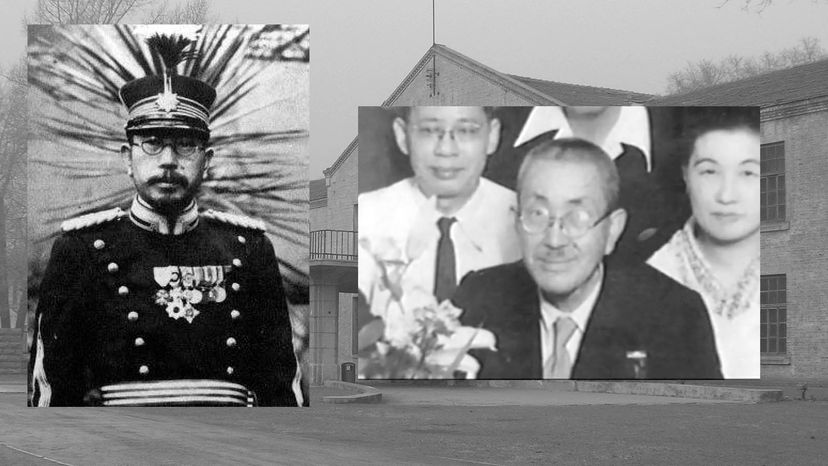
Japanese war criminals were tried at the International Military Tribunal for the Far East , otherwise known as the Tokyo War Crimes trial. Testimony from Ishii , gathered in Maryland after his postwar arrest, was used in the trial, too. But Ishii, the architect behind the Unit 731 atrocities, was never charged. He died in Tokyo in 1959, a free man.
Frequently Asked Questions
How did unit 731's activities impact international laws on human experimentation, what were the long-term health effects on survivors of unit 731's experiments.
Please copy/paste the following text to properly cite this HowStuffWorks.com article:
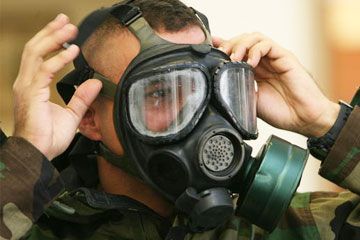
JAVASCRIPT IS DISABLED. Please enable JavaScript on your browser to best view this site.
Japan's Biological Warfare Project
Experiments.
- Harbin museum
- Yoshio Shinozuka
- Documentaries
Unit 731 and Unit 100 were the two biological warfare research centres set up in spite of the Geneva Protocol of 1925 banning biological and chemical warfare.
Led by Lieutenant-General Ishii Shiro, 3,000 Japanese researchers working at Unit 731’s headquarters in Harbin infected live human beings with diseases such as the plague and anthrax and then eviscerated them without anesthesia to see how the diseases infected human organs.
Because of the Unit’s secret nature, there is no complete list of the experiments that were undertaken by Unit 731.
Testimonies from participants shed some light about parts of the experiments. An anonymous medical assistant described in a 1995 New York Times interview his first vivisection:
“The fellow knew that it was over for him, and so he didn’t struggle when they led him into the room and tied him down. But when I picked up the scalpel, that’s when he began screaming. I cut him open from the chest to the stomach, and he screamed terribly, and his face was all twisted in agony. He made this unimaginable sound, he was screaming so horribly. But then finally he stopped. This was all in a day’s work for the surgeons, but it really left an impression on me because it was my first time.”
But the Unit was not only infamous for its vivisections. Some prisoners sent to Unit 731 were taken outside and tied to stakes. The Japanese would then test new biological weapons such as plague cultures or bombs filled with plague-infested fleas on them.
Other studies involved exposing human guinea pigs, called ‘logs’ by the Japanese scientists, to their limits. Humans were locked inside pressure chambers to test how much the body could take before their eyes popped out.
Some human test subjects were taken outside during the harsh winter until their limbs froze off for the doctors to experiment how best to treat frostbite.
Since the Japanese army used poison gas during the war, one of the Unit 731’s mission was to develop a more potent poison gas, thus prisoners were subjected to poisoning.
In 1984, a graduate student at Keio Medical University in Tokyo found records of human experiments in a bookstore. The pages described the effects of massive dosages of tetanus vaccine. There were tables describing the length of time it took victims to die and recorded the muscle spasms in their bodies.
At least 3,000 people, not just Chinese but also Russians, Mongolians and Koreans, died from the experiments performed by Unit 731 between 1939 and 1945. No prisoner came out alive of the Unit’s gates. During the war, the Japanese Imperial Army used biological weapons developed and manufactured by Unit 731’s laboratory in Harbin throughout China, killing or injuring an estimated 300,000 people.

Dangerous World
Understanding Existential Risks
Unit 731: Imperial Japan’s Biological and Chemical Warfare
Written by Romeo Jung.
Introduction
Unit 731 was a secret Biological and Chemical Warfare Unit that Imperial Japan had established during the World War II. Eager to win the war, the scientists involved committed a lot of inhumane crimes like vivisection to Chinese, Korean, Russian, and Mongolian prisoners of war, and used the data gained to harm many Chinese civilians. This essay details heavily on the biological research and its data from start to the end as well as their impacts and aftermath.
Unit 731 was established first in 1932 as a small group of five scientists interested in biological weapons, and was expanded around 1936 when Shiro Ishii was given full command of the unit. Given alternative names like “lumber yard” and “Epidemic Prevention and Water Purification Department of the Kwantung Army”, the name “Unit 731” was made formal in 1941. The lab was based at the Epidemic Prevention Research Laboratory in Japanese Army Military Medical School in Tokyo. Their purpose was none of the given names, but biological and chemical warfare research.
The idea of Unit 731 first circulated around by a memo written in April 23, 1936, that speaks about the establishment of reinforcement military forces in Manchuria. The memo states that there would be a new “Kwantung Army Epidemic Prevention Department” and that it shall be expanded later on.
The headquarters was set in three square kilometers of land in Pingfang district, Manchuria. Many of the lab’s buildings inside were hidden by a tall wall and high voltage wired fences. The lab had around 150 buildings, including incinerator, housing for prisoners, an animal house, and air field. The buildings were completely isolated from the outside world, with only a tunnel as the entrance.
Unit 731, along with two other units to be mentioned later, was created in opposition to the Geneva protocol of 1925 banning biological and chemical warfare. This protocol was signed at June 17, 1925 in Geneva. It became effective from February 8th, 1928, and got registered by League of Nations Treaty Series on September 7, 1929.
Within Unit 731, there were eight subunits designed to focus on different topics of warfare. The first division focused on biological weapons like bubonic plague, cholera, anthrax, typhoid, and tuberculosis, with human subjects to work with. The second division focused on effectively spreading the biological weapons covered in the first division. The third division was focused on a specific way of spreading biological agents by bomb, the fourth on bacteria mass production and storage. The fifth through eighth divisions were mostly focused on the supplying the rest of the Unit, which included training workers, providing equipment, and overall administrative units.
Outside of Unit 731, Japan established two departments: Unit 100 and Unit 516. Unit 100 was first declared as the “Kwantung Army Military Horse Epidemic Prevention Workshop,” which focused on developing biological weapons aside from Unit 731. “Kwantung Army Technical Testing Department”, later called Unit 516, was also established for more research that focused on chemical weapons.
People Involved
There were many involved with the research of Unit 731, most of them remaining anonymous to this day. Shiro Ishii was the Chief of Unit 731, with Masaji Kitano as second in command. Other scientists were most likely to be a Professor at an university or a chief of a medical research unit, like Dr. Hisato Yoshimura, who directed the frostbite experiments on subjects, and Dr. Hideo Futaki, who lead the tuberculosis research squad and some vivisections. Other personnels include Lieutenant Shunichi Suzuki, who, after the trials, went to work as the Governor of Tokyo, and Amitani Shogo, who remained at the lab afterwards and received the Asahi Prize for outstanding scientific performance.
Shiro Ishii served in the Imperial Japanese Army from 1921 to 1945, and in the meantime, he was a Japanese army medical officer, microbiologist, and the director of Unit 731. Before serving in the army, he had studied medicine at Kyoto Imperial University. He was first assigned as an army surgeon, then to the First Army Hospital and Army Medical School in Tokyo. His work soon impressed the superiors, which earned him postgraduate level medical education. Ishii was promoted to an army surgeon in 1925, and was advocating for a biological weapons research program.
After getting promoted to higher ranks, Ishii began his experiments in Zhongma Fortress for biological weapons. Then the government granted him permission to set up Unit 731 in his hopes of digging deeper into the topic. After World War II, he was arrested for a short time by the US occupation authorities for Unit 731, then received immunity from consequences in exchange for data. There are different accounts as to what he did after that, but some say that he traveled around to give talks about biological weapons and others say that he stayed in Japan to provide medical services for free.
What They Did
In Unit 731, the first division conducted many outrageous experiments which were violating human rights. They conducted many experiments that tested the limitations of the human body. The prisoners, used as subjects, were of mixed ethnicity and gender, some pregnant, and some as young as three years old. The prisoners, tied to stakes, would have to endure the biological agent bombs that carried plague infested fleas on them or rats with the diseases. Then they were subject to their body being cut open with a scalpel and examined while they were screaming for mercy on the table.
An unnamed Unit 731 surgeon, in an interview with New York Times, described his experience with the unit. His first vivisection, which he recalled that he “cut [the prisoner] open from the chest to the stomach, and he screamed terribly, and his face was all twisted in agony… …finally he stopped. This was all in a day’s work for the surgeons…” (Kristof) There was no use of anesthetics during vivisections at all because they were afraid that it would have an effect on the results and data.
In another part of his article, Kristof interviews a former medical worker in Unit 731, Takeo Wano. Wano says that he had seen “six-foot-high glass jar in which a Western man was pickled in formaldehyde. The man had been cut into two pieces, vertically.” There were many other jars in the headquarters of Unit 731 containing other body parts from different people, labeled often as their ethnicity. An anonymous Unit 731 veteran says that most of the jars had been noted as Chinese, Korean, and Mongolian, although there were occasionally American, English, and French. Some body parts were even sent in from other places.
Other experiments included prisoners being locked inside a pressure chamber to test how much pressure the body can handle before their eyes started popping out, being exposed to poisonous gas and many more biological and chemical weapons, having limbs cut off for studying blood loss, having cut off limbs attached to different parts of the body, having horse urine injected into kidneys, and having lethal dosages of x-rays. Kristof noted that “The accounts are wrenching to read even after so much time has passed: a Russian mother and daughter left in a gas chamber, for example, as doctors peered through thick glass and timed their convulsions, watching as the woman sprawled over her child in a futile effort to save her from the gas.”
Hisato Yoshimura, apart from infection based experiments, led the frostbite experiments, which focused on the effects of frostbite on human limbs. He gave orders to freeze limbs of prisoners, often until they were black. The prisoners were let in only when an officer was sure that their limbs were frozen. The officers would test limbs by beating them with a stick, as they knew that frozen limbs sound like wooden boards upon hitting.
After chilling prisoners’ limbs to near 0 degrees Celsius with ice water, Yoshimura continued to chop off parts of the limb, especially fingers, so that he may record how the frostbite was affecting human limbs. He and his team experimented on subjects as young as three years old, with a needle in their finger to keep it from clenching into a fist.
Effects During War
The Japanese Military used the biological weapons developed by Unit 731 directly on Chinese civilian population. Agents in divisions other than the first division in Unit 731 would spread the diseases by train, road, and airplanes. Many Chinese civilians developed the worst infections on their limbs, and only a few were exposed to treatment since no local doctors or hospitals had seen the infections before.
Quzhou village, Ya Fan village, and Chong Shan village in the Zhejiang Province had suffered deeply from the Bubonic Plague, as well as Dysentery, Typhoid, Cholera, and many more. In an episode of BBC Correspondent, Wu Shi-Gen, a victim of Unit 731’s biological weapons, tells his story of how the Bubonic Plague had affected his nine-year old brother. The rest of the family chose to lock his little brother away in another room to minimize the possibilities of infections while the little boy cried out from the room. Wu said he still remembers how he could not run in and help his brother when he cried out in pain.
Ya Fan village was affected with an unknown infection, commonly known to residents as “The Rotten Leg Disease.” A victim of this infection describes it as something that “started like an insect bite, then swelling and unbearable pain. Then his flesh started rotting away. Many died of it. Experts say it’s probably Glanders, another of Unit 731’s special recipes. Treatments were ineffectual and cost a fortune.” He stated that while his mother and he both had the disease on their legs, she refused the medicine so that he could have it instead of her. She passed away a few months later.
Aside from negative effects, Unit 731’s research was also used to heal Japanese soldiers with certain conditions. Studying about human conditions like frostbites and different diseases, the doctors could effectively pinpoint medical solutions for their sick soldiers. For instance, the frostbite experiment revealed that putting frozen limbs in water from 100 to 122 degrees Celsius is the best.
As soon as the World War II was over, the scientists at Unit 731’s headquarters started burning the building down, getting rid of all the evidence. When Shiro Ishii and many others were captured by China and sent over to the US for a trial, they had a deal with President MacArthur. He decided to let go of the Unit 731’s scientists free of charge for the war crimes in exchange for their medical research data.
In addition, Japanese government was fairly late to apologize to the rightful victims of Unit 731, while paying war tributes to the dead war criminals of Unit 731. They have been continuously visiting their shrines every year since 2013, offending neighboring countries and victims. Many news articles had been written about it, yet they do not seem to matter to the Japanese government.
Many Japanese scholars also deny the fact that there was ever a Unit 731 and state that the history involving the group is fabricated, although there are plenty of evidences. The Japanese history textbooks do not cover most of Japan’s horrific acts in World War II, leading them to believe that Japan was mostly a victim country rather than hostile like their opponents. By large, the Japanese public has a false sense of history due to the fact that their history textbooks are skewed.
The former members of Unit 731 seem to have conflicting opinions about the publicity of the topic. Yoshio Shinozuka and some others had gone to give talks and share information about Unit 731, but others like Toshimi Mizobuchi intend to keep the promise to hide the information. A portion of Unit 731 members still hold their annual staff reunion parties hosted by Mizobuchi.
Unit 731 has been one of of the most cruel groups to do human experimentation, yet so few people that I’ve met know about what really happened. Although these inhumane experiments could be defended by saying that they were useful for modern medical science, they were definitely not worth the cost of many civilian lives as well as prisoners’ suffering.
Maruta — “Log” in Japanese. Prisoners were often called logs so that they could be experimented on without scientists feeling remorse.
Vivisection — Much like dissection, but with an alive person.
Unit 731: Japan’s Biological Warfare Project. (2018). Retrieved March 14, 2018, from https://unit731.org/ Kristof, N. D. (1995, March 17). Unmasking Horror — A special report.; Japan Confronting Gruesome War Atrocity. Retrieved March 24, 2018, from https://www.nytimes.com/1995/03/17/world/unmasking-horror-a-special-report-japan-confronting-gruesome-war-atrocity.html?pagewanted=all L. (2013, February 11). Unit 731: Japan’s biological force. Retrieved March 24, 2018, from https://www.youtube.com/watch?v=8LfMNX3TsT0 Working, R. (2001, June 5). The trial of Unit 731. Retrieved March 24, 2018, from https://www.japantimes.co.jp/opinion/2001/06/05/commentary/world-commentary/the-trial-of-unit-731/#.WqoQ6z9zJhE McCurry, J. (2013, December 26). Japan’s Shinzo Abe angers neighbours and US by visiting war dead shrine. Retrieved March 24, 2018, from https://www.theguardian.com/world/2013/dec/26/japan-shinzo-abe-tension-neighbours-shrine Beijing, S. A. (2014, October 17). China protests at Japanese PM’s latest WW2 shrine tribute. Retrieved March 24, 2018, from https://www.theguardian.com/world/2014/oct/17/china-protests-japan-shinzo-abe-yasukuni-shrine Japanese PM Abe sends ritual offering to Yasukuni shrine for war dead. (2017, October 17). Retrieved March 24, 2018, from https://www.reuters.com/article/us-japan-yasukuni/japanese-pm-abe-sends-ritual-offering-to-yasukuni-shrine-for-war-dead-idUSKBN1CL355 Abe training jet photo sparks outrage in South Korean media. (2013, May 15). Retrieved March 24, 2018, from http://www.scmp.com/news/asia/article/1238533/abe-training-jet-photo-sparks-outrage-south-korean-media Tsuneishi, K. (2005, November 24). Unit 731 and the Japanese Imperial Army’s Biological Warfare Program. Retrieved March 24, 2018, from https://apjjf.org/-Tsuneishi-Keiichi/2194/article.html Pure Evil: Wartime Japanese Doctor Had No Regard for Human Suffering. (2016, June 15). Retrieved March 24, 2018, from https://www.medicalbag.com/despicable-doctors/pure-evil-wartime-japanese-doctor-had-no-regard-for-human-suffering/article/472462/ Tsuchiya, T. (2007, December 16). Retrieved March 24, 2018, from http://www.lit.osaka-cu.ac.jp/user/tsuchiya/gyoseki/presentation/UNESCOkumamoto07.html Unit 731: One of the Most Terrifying Secrets of the 20th Century. (n.d.). Retrieved March 26, 2018, from https://www.mtholyoke.edu/~kann20c/classweb/dw2/page1.html
Share this post:
Leave a reply cancel reply.
Your email address will not be published. Required fields are marked *
Save my name, email, and website in this browser for the next time I comment.

ALLIANCE FOR HUMAN RESEARCH PROTECTION
Advancing Voluntary, Informed Consent to Medical Intervention

- Board of Directors
- Distinguished Advisory Board
- Honor Roll–Exemplary Professionals
- First, do no Harm
- Human Rights
- Informed Consent
- Nuremberg Code
- Discrimination
- Medicalized Racism
- Gene Modification
- Depopulation
- Technocracy
- Propaganda – Censorship
- Clinical Trials
- Concealed Data
- Public-Private Partnerships
- Pharma Corrupt Influence
- Publication Bias
- Organ Harvesting
- Bioweapon Experiments
- Transhumanism
- Current Medical Atrocities
- Japanese Atrocities
- Nazi Atrocities
- Operation Paperclip
- CIA Mind-Control
- CIA Torture
- U.S. Radiation Experiments
- Unethical Experiments
- Pandemic Control
- Great Reset
- Diabolical Lockstep
- Apartheid Policies
- Coronavirus Fear
- Covid Pandemic
- Government Overreach
- Vaccine Profit Engine
- Child Sacrifice
- Vaccine Mandates
- Vaccine Risks
- Vaccine Safety
December 10
1936–1945: Unit 731 — the Asian Auschwitz
Japanese Medical Atrocities
1936–1945: Unit 731 — the Asian Auschwitz — was a massive biological warfare research program of the Japanese Imperial Army under the command of Lt. General Dr. Ishii Shiro in Pin Fang, Manchuria outside the city of Harbin. Its true purpose was masked as the Epidemic Prevention Research Laboratory. Unit 731 was housed within 150 buildings with a staff of 3,000. It included an aerodrome, railway line, barracks, dungeons, laboratories, operating rooms, crematoria, cinema, bar and Shinto temple. Its barbarous inhumane experiments rivalled the infamous Nazi death camp of Auschwitz-Birkenau, though the numbers of prisoners were smaller, it operated for a much longer period. From 1936 to 1942 between 3,000 and 12,000 men, women and children were subjected to unspeakable diabolical experiments, vivisected while still alive, before they were slaughtered in Unit 731. (C. Hudson, Doctors of Depravity , 2007; Nightmare in Manchuria, 2012; Unit 731 )
Shiro Ishii’s extensive deadly human experiments were under the protection of the Kanto Army High Command, the Kampeitei (secret Japanese police), and local police collaborators. His first laboratories were in the city of Harbin, later in Beiyinhe, and still later in an extraordinary facility in Harbin’s suburb known as Ping Fang. Construction began in 1936, and was completed in 1939. Originally named Togo, later changed to Ishii Unit, finally it was named Unit 731; it was the world’s largest premier biological and chemical warfare research center.
“Each year hundreds of prisoners were fodder for fiendish experiments. They were exposed to every known disease. These ranged from anthrax to yellow fever. Some were used for hyperthermia experiments. Others were forced to endure gangrene experiments; and still others were forced to engage in sexual intercourse with individuals known to be infected with venereal diseases. They were then monitored as the disease took its toll on the victims.” “The victims were captured communist partisans, ordinary criminals, political dissidents, those who were mentally handicapped but physically fit, and, when candidates among these groups were scarce, the secret police would pick up the poor, the homeless, off the streets in cities throughout occupied China and Manchuria. The police would be given orders to send prisoners to Harbin/Ping Fan by “Special Delivery.” “Everyone engaged in this sordid business understood that “Special Delivery” was the code words for new human experimental prey. Prisoners to be tested were of various nationalities. The overwhelming majority were Han Chinese. However, Koreans, Soviet prisoners of varying ethnic backgrounds, and, occasionally, Europeans and Americans were used.” “Victims were frequently vivisected while still living. They were not given an anesthesia since Ishii and his colleagues wanted to be certain that their tests were not influenced by an outside source. Those individuals whose experiments required a course of study usually lasted about six weeks. Then, of no longer any value to the researchers, they were “sacrificed”, the euphemism used instead of “killed.” The bodies, men, women, and children, would then be dissected by pathologists, and, eventually, deposited in either large burial pits or burned in the three crematoria housed at Ping Fan.” (Sheldon Harris. Japanese Medical Atrocities in WWII: Unit 731 Was Not An Isolated Aberration .” A paper read at the International Citizens Forum on War Crimes & Redress, Tokyo, Dec. 11, 1999)
Unit 731 was divided into eight divisions: Division 1: Research on bubonic plague , cholera , anthrax , typhoid and tuberculosis using live human subjects in a prison was constructed to contain around 300 to 400 people. Division 2: Research for biological weapons used in the field, in particular the production of devices to spread germs and parasites. Shiro Ishii, the mastermind behind Japan’s biological warfare — “Factories of Death” — was a brash and flamboyantly corrupt man who considered himself a visionary” beyond scruples. He was brilliant, charming, intimidating, stone-hearted, driven to break new scientific ground and to help Japan defeat its foes. Ishii exhorted his team of physicians to violate the physicians’ ethical code:
“A doctor’s God-given mission is to challenge all varieties of disease-causing micro-organisms; to block all roads of intrusion into the human body; to annihilate all foreign matter resident in our bodies; and to devise the most expeditious treatment possible. . . However, the research we are now about to embark is the complete opposite of these principles, and may cause us some anguish as doctors.” “We pursue this research,” he explained, “for the double medical thrill; as a scientist . . . probing to discover the truth in natural science; and as a military person, to build a powerful military weapon against the enemy.” (Patrick Fong. Impunity Of Japan’s Secret Biological Warfare Unit , 2000.)
Unspeakably cruel and ghoulish experiments were conducted by Japanese physicians who had been recruited from Japan’s leading academic medical institutions. Like their Nazi counterparts, Japan’s physicians perverted the essence of medicine. Doctors in the biological war program turned life – biology – against life.
They referred to the prisoners as Maruta (“logs” whose killing was comparable to cutting down a tree). Army surgeons conducted many vivisections “for training purposes” — in truth, to desensitize them. The victims were mostly Chinese — men, women, and children, including pregnant women and infants. Soviet, Australian and several American prisoners of war were also subjected to experiments designed to infect the victims with fatal diseases including: plague, cholera, tuberculosis, typhoid, tetanus, anthrax, typhus, hemorrhagic fever, and dysentery. See, list “medically usable specimens” (i.e., pathogens) compiled in a U.S. occupation report . The victims were then vivisected — many while still alive. Live vivisection was a Japanese “specialty.”
The experiments conducted at Unit 731 and its satellites can be classified into the following broad categories: Vivisections for training new Army surgeons: These were performed at army hospitals in China using many Chinese prisoners. The doctors were trained to perform appendectomies and tracheotomies; prisoners were shot, then doctors removed the bullets from their bodies; they amputated their arms and legs and sewed up the skin around the wounds, and finally killed the prisoners. This surgical training program was to teach newly minted army surgeons how to treat wounded soldiers at the front lines. However, unlike normal medical training which teaches surgical skills while avoiding causing harm to patients, the training of these army doctors encourages causing needless harm and death. So, it has been suggested that training under Unit 731 supervision, was not required at all, but rather its main purpose was to desensitize the surgeons, rather than to perfect their surgical skills. (Takashi Tsuchiya. Why Japanese doctors performed human experiments in China 1933-1945 , Eubios Journal of Asian and International Bioethics, 2000)
Intentional infecting with viruses and pathogens followed by vivisection either after death or vivisected to death. Doctors purposefully infected victims with diseases ; victims would then be strapped down to an operating table and subjected to live autopsy without anesthesia. Some screamed in a non-human way when they realized their fate. Unit 731 “doctors” would cut them open to observe the progress of the germs incubating within them or to harvest organs that had enough germs to weaponize or spread on nearby villagers. They would amputate limbs to study blood loss and the effects of rotting and gangrene (some limbs were later attached to the other side of the body), parts of the stomach, liver, brains and lungs were often removed to observe the effects. The reason for live vivisection was to study the effect of the pathogens on live human organs and to avoid decomposition.
Germ warfare , male and female prisoners were injected with venereal diseases in the disguise of inoculations (or sometimes infected via rape) to determine the viability of germ warfare, victims were infested with fleas in order to communicate the disease to an organism which could be later dropped onto a populace. During one anthrax operation, the doctors noted the progress of the pathogen organ by organ. The victim’s suffering was unspeakable, with “his organs swelling, bleeding and disintegrating.” Fleas were also tainted with cholera, anthrax, and the bubonic plague, as well as, other plagues. This was the origin of the “flea bomb” which infected large geographic areas and polluted land and water. They were dropped in the guise of clothing and supplies which resulted in the estimated death of another 400,000–580,000 Chinese civilians. (Read more: China History Forum , 2005.)
Weapons testing, grenades, mortars and other explosive devices were detonated near living targets to determine the effects with regards to different distances and angles, so they could determine how long victims could survive with their sustained injuries; experiments to determine the ability of the human body to survive in the face of various pathogens and in conditions such as extreme cold; Chinese prisoners were exposed to mustard gas in a simulated battle situation; others were tied to stakes tests to determine the lethality of biological, and chemical weapons and other explosive material.
Physical endurance experiments, to determine the physical tolerance level of human beings. The experiments were designed to answer questions such as: how much air could be injected intravenously; how much poison gas could be inhaled; how much bleeding caused death; how many days prisoners could survive without food or water; how high electric current human beings could bear; air pressurized, oxygen deprivation experiments — same as those conducted in Nazi concentration camps; frostbite experiments where prisoners would lose entire limbs and suffer gangrene; forced sex between prisoners (most often one that was infected with a STD while the other was healthy). In other experiments victims were hung upside down to observe how long it took for one to die due to choking and the length of time until the onset of embolism occurred after inserting air into ones blood stream. Read more: Unit 731
Nonstardized treatment tests and Sadistic what if? Experiments . Numerous experimental vaccines were tested on prisoners with no animal trials; Victims were hung upside down to observe how long it took for one to die due to choking; the length of time until the onset of embolism occurred after inserting air into ones blood stream; what would happen if horse serum got injected into the body of a human?
“Other experiments were conducted so the doctors could learn more about how humans live and die. These included studies of dehydration, starvation, frostbite, air pressure – some inmates had their eyes blown out – transfusions of animal blood to humans and others. Even children and babies were destroyed this way. Other ghoulish experiments included cutting off a prisoner’s hands and sewing them back on to the opposite arms to gauge what happened.” ( China History Forum , 2005)
Subscribe To Our Newsletter!
Sign up and be the first to find out the latest news and articles about what's going on in the medical field.
You may also like
October 18, 2024
To Obey or Not Obey with Holocaust Survivor Vera Sharav
Vera Sharav is a Holocaust survivor and founder of the Alliance for Human Research Protection. She’s spent
Palestine – A Globalist Genocide – WAGE PEACE with Shabnam Palesa Mohamed and Vera Sharav (Part 1/3)
PART 1: “Why are you anti-war? Because war is anti-human. Palestine is a globalist genocide.” Vera Sharav.

IMAGES
VIDEO